🕵️♂️ Mystery History Quiz – Powering Los Angeles |
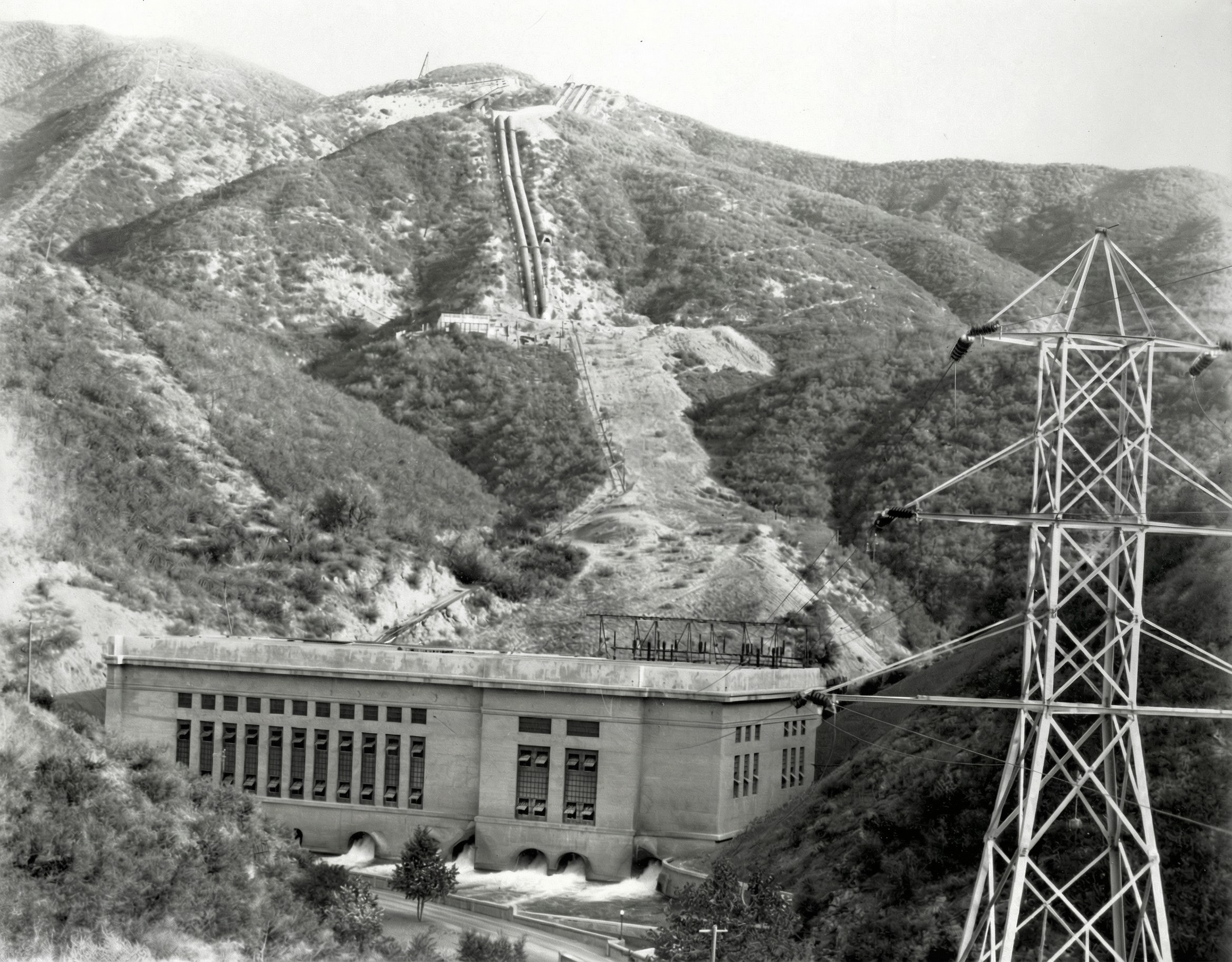 |
|
| A 1928 view of an early Los Angeles Aqueduct hydroelectric facility, showing the powerhouse in the canyon, the 115-kV transmission tower in the foreground, and the steep penstocks carrying high-pressure water down to the turbines. Completed in the 1910s, it was the first hydroelectric powerhouse built by the City of Los Angeles to deliver commercial electricity to its residents. Remarkably, this historic facility still operates today — more than a century after it first began generating power. |
-
Where along the Los Angeles Aqueduct system was this hydroelectric plant located?
A) Owens Valley
B) Mono Basin
C) San Francisquito Canyon
D) San Fernando Valley -
-
What is the name of the hydroelectric plant shown in this 1928 photograph?
A) Division Creek Power Plant
B) Power Plant No. 1
C) Cottonwood Power Plant
D) Kern River No. 1 -
What made this hydroelectric plant historically significant?
A) It was the first private power plant in Southern California
B) It supplied electricity only to Owens Valley construction camps
C) It was the first hydroelectric powerhouse built by the City to deliver commercial electricity to Los Angeles residents
D) It provided backup power for Los Angeles Harbor -
-
When the plant first opened in 1917, how much of Los Angeles’s power demand did it supply?
A) About 10%
B) Around 35%
C) More than 70%
D) Nearly 100% -
-
This hydroelectric plant is still in operation today. On average, what percentage of Los Angeles’s power needs does it supply now?
A) About 10%
B) Around 3%
C) Close to 1%
D) Less than 0.1%
🕵️♂️ Mystery History Bonus Question
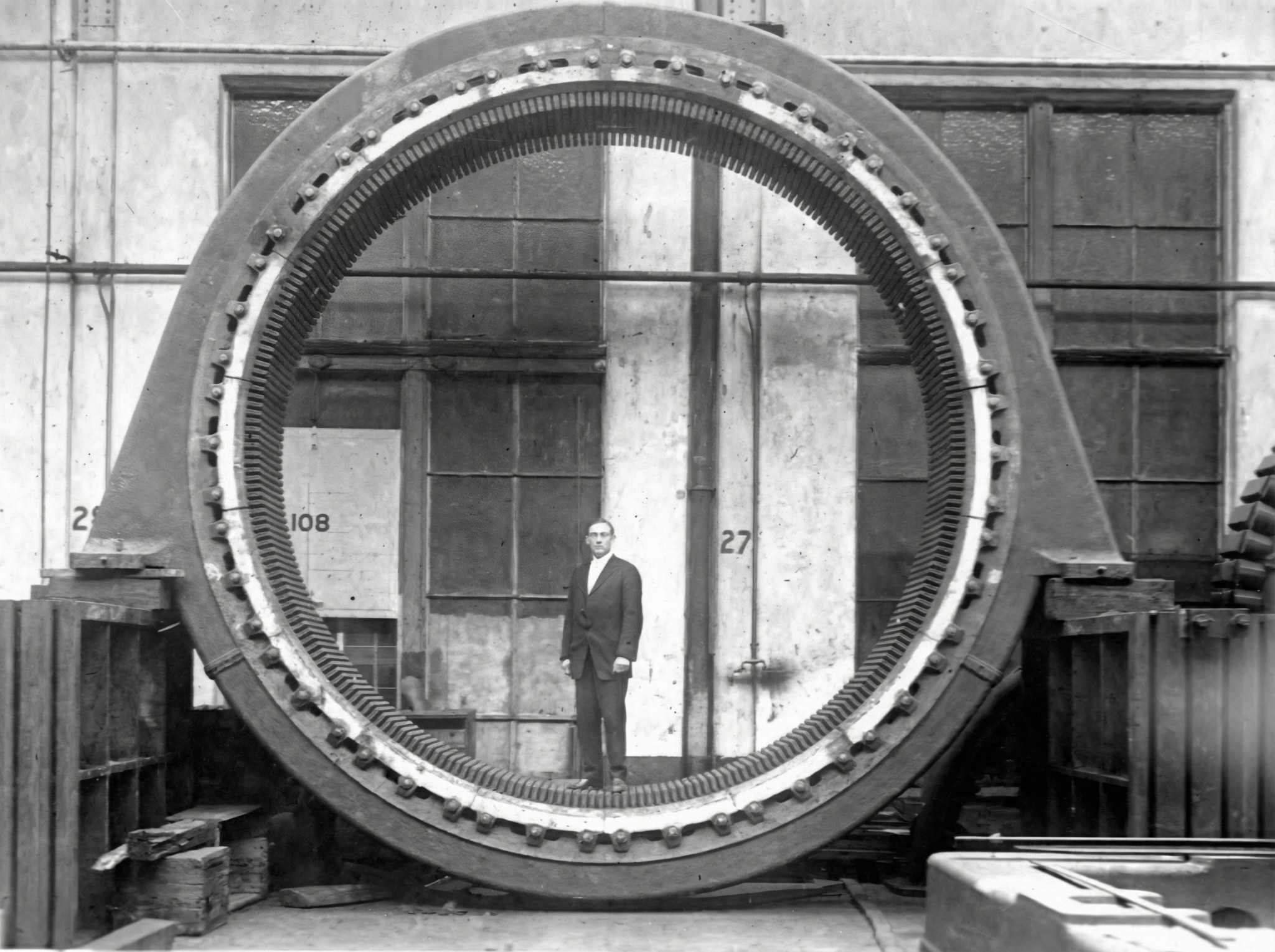 |
|
1916 - Inside the Stator Ring |
Hydroelectric powerhouses along the aqueduct required enormous machinery to convert falling water into electricity. In this 1916 photograph, a worker stands inside a massive circular component being assembled for one of the early hydroelectric plants on the Los Angeles Aqueduct.
What part of the hydroelectric machinery is he standing inside?
A) The main water inlet for the penstocks
B) The stationary portion of the generator
C) The housing for the Pelton wheel buckets
D) A pressure-relief chamber for the outlet tunnels
📲 Think you got them all right?
Check your answers and explore more about Los Angeles’s early hydroelectric power system — HERE.
* * * * * |
Mystery History Question (October 2025)
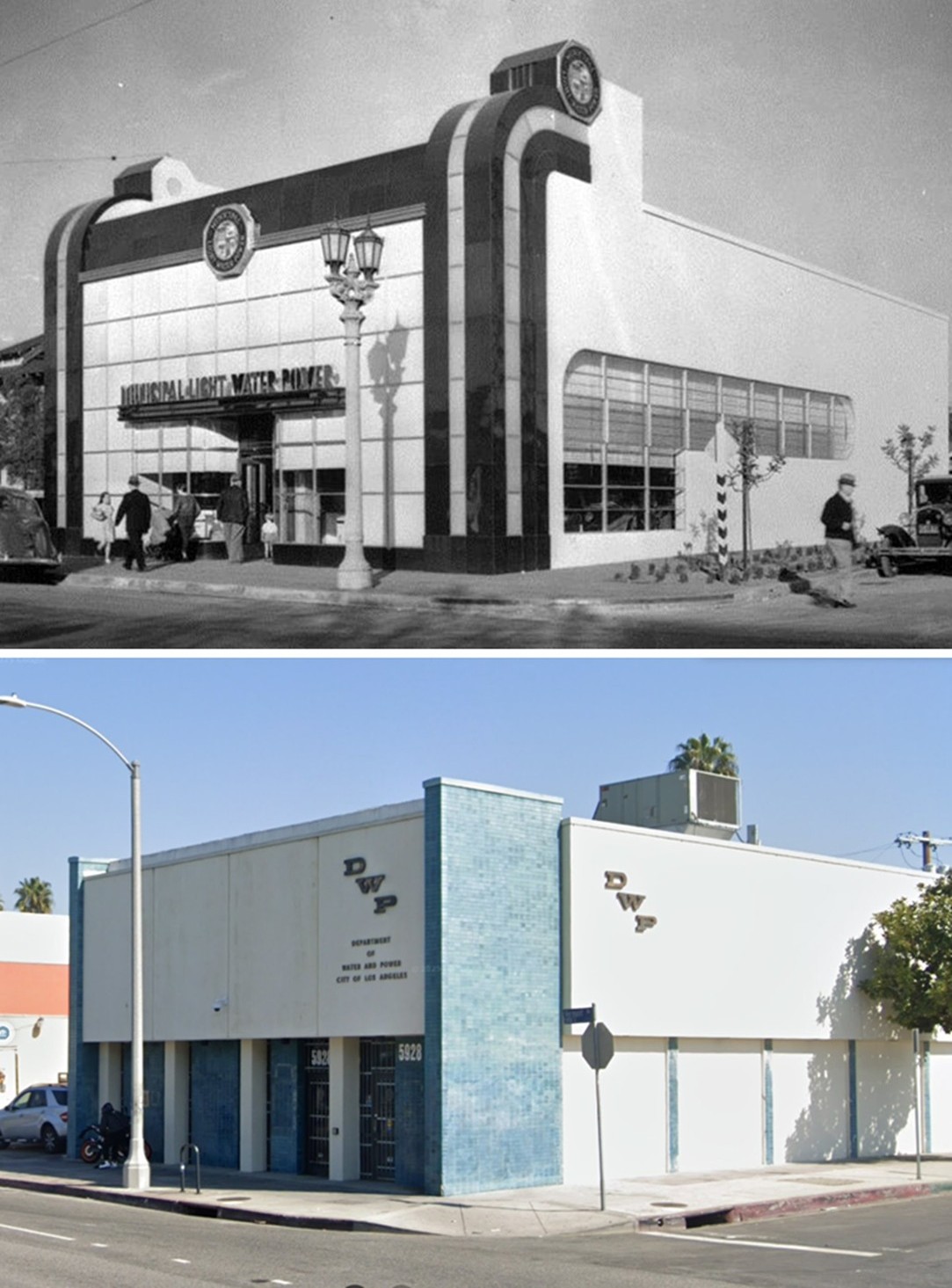 |
|
| 📸 Then & Now – Vermont Avenue Branch Commercial Office |
Above: In the mid-1930s, the new Vermont Avenue Branch Commercial Office of Municipal Light, Water & Power opened at Vermont Avenue and 59th Place. Designed by a noted Los Angeles architect, the sleek Streamline Moderne building quickly earned a glittering nickname for its illuminated glass façade. Below: The same building decades later—remodeled and stripped of its original Moderne styling, but still serving the community today as LADWP’s Vermont–Slauson Customer Service Center. |
🕵️♂️ Mystery History Quiz - Vermont Avenue Branch
1. Who designed the original 1936 Vermont Avenue Branch office?
A) John Parkinson
B) Julia Morgan
C) S. Charles Lee
D) Richard Neutra
E) Paul R. Williams
2. What nickname was given to the Vermont Avenue Branch because of its illuminated glass façade?
A) The Crystal Palace
B) The House of Glass
C) The Sparkle Box
D) The Electric Pavilion
E) The Water & Power Glow
3. At night, what made the building stand out as an advertisement for the utility?
A) Neon signs on the roof
B) A giant rooftop spotlight
C) The entire glass front lit up like an electric sign
D) Rotating searchlights on the corners
E) Projected films of water and power scenes
4. When did the name officially change to the Department of Water and Power (LADWP)?
A) 1927
B) 1937
C) 1947
D) 1957
E) 1967
5. The Vermont Avenue Branch once handled 26,000 bills a month — more than any other branch office. What does this suggest about the location?
A) It was in a sparsely populated area
B) It served the busiest residential section in Los Angeles
C) It was mainly an industrial district
D) It served only government buildings
E) It had fewer customers than any other branch
6. Which other LADWP branch office did S. Charles Lee design that still stands today?
A) Lincoln Heights Branch
B) Boyle Heights Branch
C) Wilshire Branch
D) Van Nuys Branch
E) Hollywood Branch
7. What modern feature did the Vermont Avenue Branch highlight to promote electric living in the 1930s?
A) A rooftop garden
B) Demonstrations of household appliances
C) A drive-through bill-pay station
D) A public movie theater
E) An indoor fountain
📲 Think you got them all right?
Check your answers and explore the full story of the Vermont Avenue Branch—including its architect, nickname, and surprising transformation--HERE.
* * * * * |
Mystery History Question (July 2025)
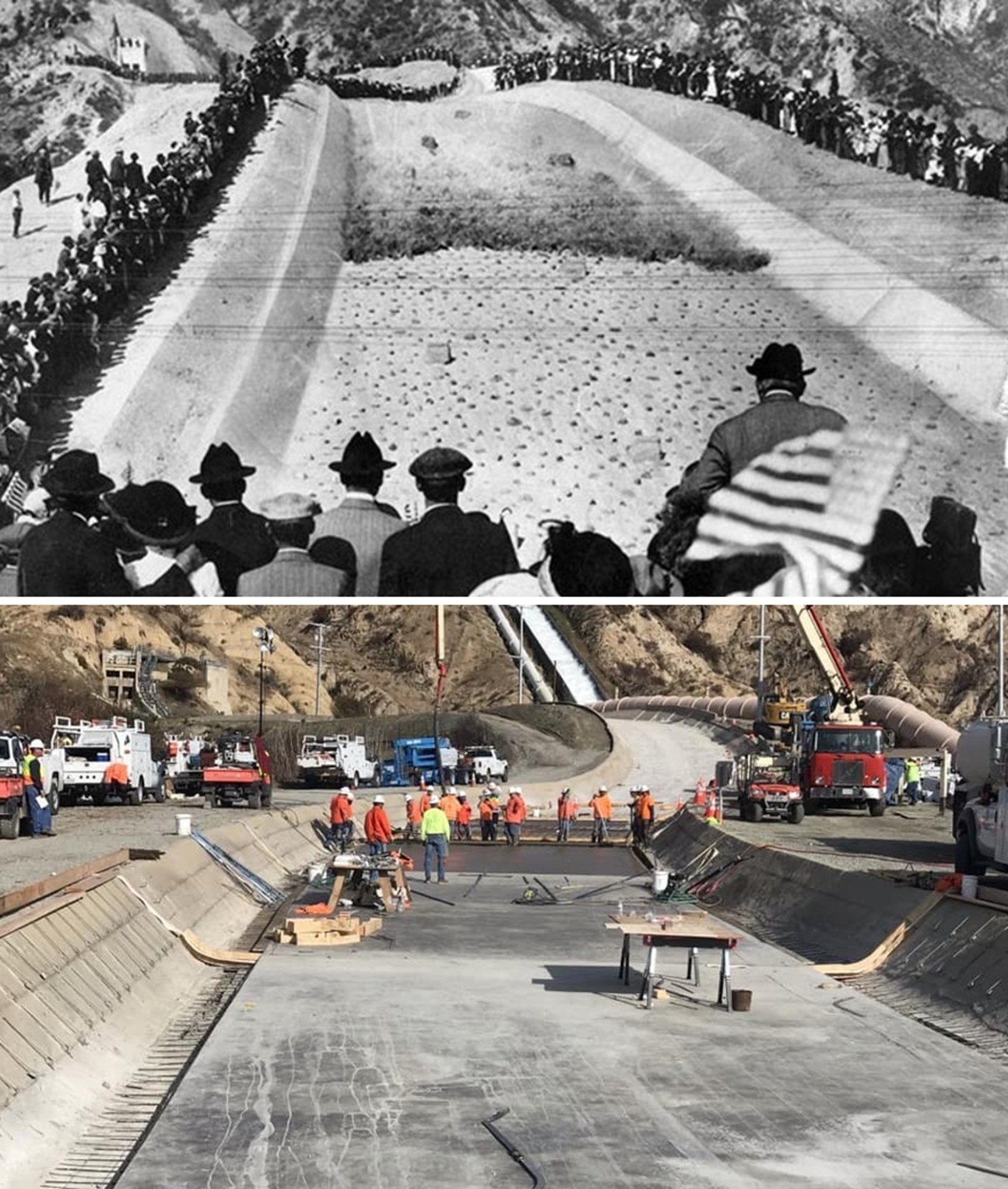 |
|
| 📸 Then & Now – The Cascades of the Los Angeles Aqueduct, Sylmar |
Above: The historic 1913 opening ceremony of the Los Angeles Aqueduct, where water first cascaded down into the San Fernando Valley—a moment that marked Los Angeles’ transformation from a small city to a booming metropolis. Chief Engineer William Mulholland, who directed this ambitious project, can be seen standing above the American flag, moments before delivering his iconic words: “There it is—take it.” Below: A modern view of the same site shows the cement relining of the original Cascade, part of the ongoing maintenance to preserve this vital infrastructure. At the top of the image, note a second cascade channel and a large pipeline—infrastructure related to the lesser-known Second Los Angeles Aqueduct, a major expansion that quietly reshaped the region’s water supply system. |
 |
|
| 2011 - Terminus of the First and Second Los Angeles Aqueducts with both cascades flowing at full capacity. |
🕵️♂️ Mystery History Quiz – The Hidden Story of L.A.’s Second Aqueduct
1. Why was the Second Los Angeles Aqueduct constructed?
A) To replace damaged sections of the First Aqueduct
B) To meet rising demand and secure L.A.'s rights to Owens Valley and Mono Basin water
C) To irrigate farms in Inyo County
D) To route water around earthquake faults
2. When was the Second Los Angeles Aqueduct completed?
A) 1941
B) 1958
C) 1970
D) 1983
3. Where does the Second Aqueduct branch off from the original?
A) Mono Lake
B) Owens Lake
C) Haiwee Reservoir
D) San Fernando Reservoir
4. Who managed the construction of the Second Aqueduct?
A) California Department of Water Resources
B) Private contractors under LADWP
C) U.S. Army Corps of Engineers
D) Original city public works crews from the 1913 project
5. What is the function of the large pipes visible adjacent to the cascades in Sylmar?
A) Backup overflow for emergencies
B) Abandoned conduit from early electric generation
C) Penstock delivering high-pressure water to hydroelectric turbines
D) Water transfer from Sylmar to San Diego
6. How did the Second Aqueduct impact L.A.’s water delivery system?
A) It had no real effect on supply
B) It reduced evaporation losses from the First Aqueduct
C) It increased the city's water import capacity by approximately 50%
D) It was only activated during drought emergencies
7. What dual-purpose function is exemplified at the Cascades in Sylmar?
A) Water treatment and recreation
B) Wildlife migration and sediment collection
C) Scenic viewing and noise reduction
D) Water delivery and hydroelectric power generation
8. When is water most likely to flow visibly down the cascades?
A) Every day at noon as a showpiece
B) During major rainstorms
C) During peak electricity demand
D) When the hydroelectric power plants are offline or cannot handle the full flow
📲 Think you got them all right?
Check your answers and explore the full story of the Second Los Angeles Aqueduct—including its role in power generation and how it works in tandem with the original 1913 aqueduct—HERE.
* * * * * |
Mystery History Question (April 2025)
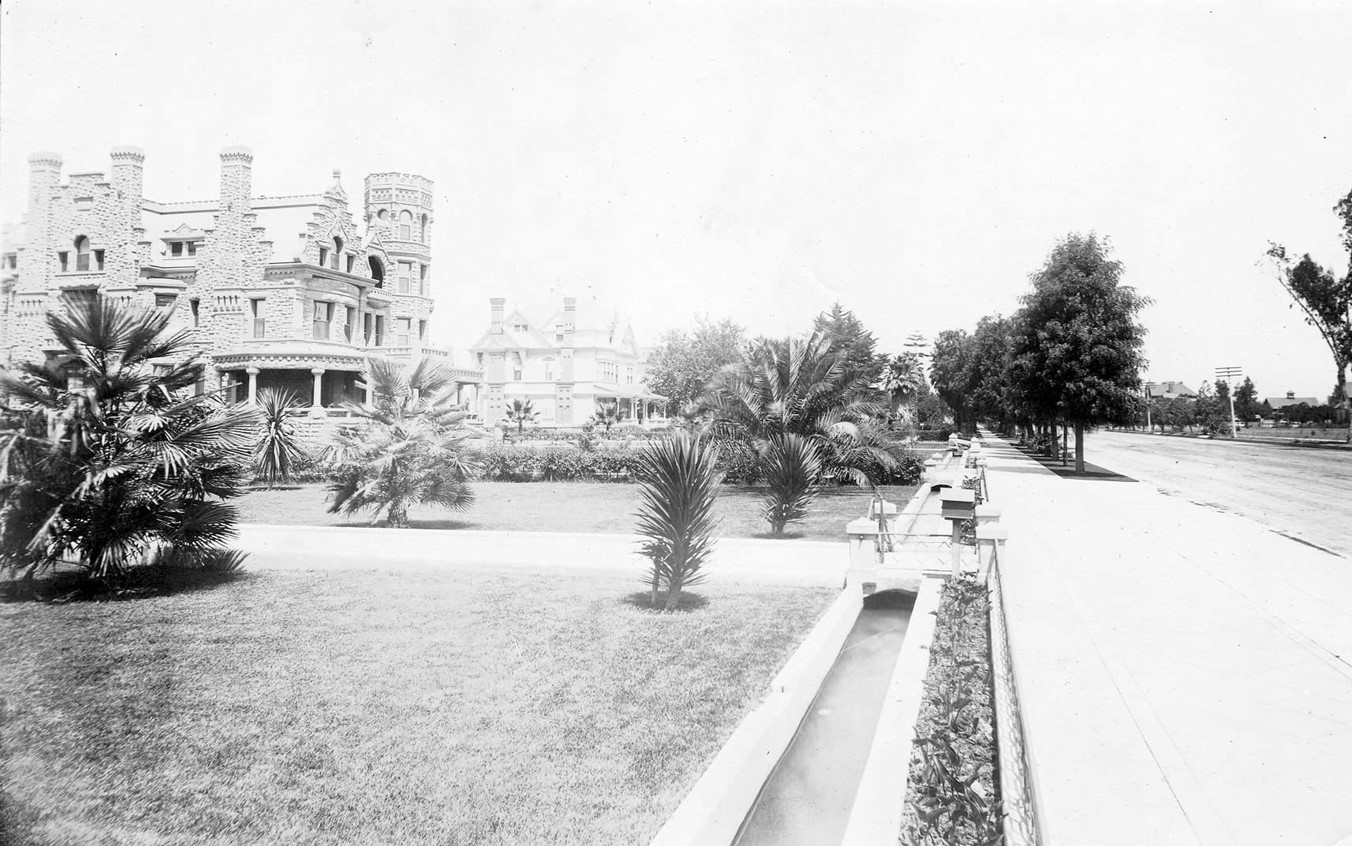 |
|
| (1890s) – View looking north along Figueroa Street, showing a prominent water ditch (zanja) running parallel to the property line. Today, the castle-like Stimson House at 2421 South Figueroa Street (seen in upper-left) still stands, along with visible remnants of the zanja. |
The zanja system was the original water supply for Los Angeles, with its roots tracing back to the city's founding in 1781. The first zanja, known as the Zanja Madre (Mother Ditch), was an earthen channel that diverted water from the Los Angeles River to the nascent pueblo. Over time, this system expanded significantly, reaching its peak with 52 miles of zanjas irrigating nearly 7,000 acres within city limits by the 1880s.
The era of the zanjas came to an end in 1904 when William Mulholland, who had overseen both the zanja and piped water systems, officially closed the open-ditch network. This decision marked a significant shift in Los Angeles' water management, fully embracing the modern piped system.
What was a significant challenge faced by the zanja system as Los Angeles grew in the late 1800s?
A) The zanjas became clogged with sediment, leading to a severe water shortage. B) Open trenches were prone to contamination from public dumping and pollution, raising health concerns. C) The zanja system was unable to reach new developments, causing delays in construction projects. D) The system was overwhelmed by rapid population growth, and local officials were unable to find a solution. |
Why did William Mulholland decide to shut down the zanja system in 1904, and what impact did this decision have on Los Angeles’ water infrastructure?
A) The zanjas were permanently damaged in an earthquake, forcing the city to rely solely on piped water. B) The system became too expensive to maintain, and Mulholland wanted to shift all water into pressurized mains for efficiency. C) The city banned open water sources due to a cholera outbreak, making the transition to pipes necessary for public health. D) The Zanjas were abandoned after the Los Angeles Aqueduct was completed, making them obsolete. |
Click HERE for answers in our new section: From Zanjas to Mains – The Evolution of Los Angeles' Water System. |
* * * * * |
Mystery History Question (January 2025)
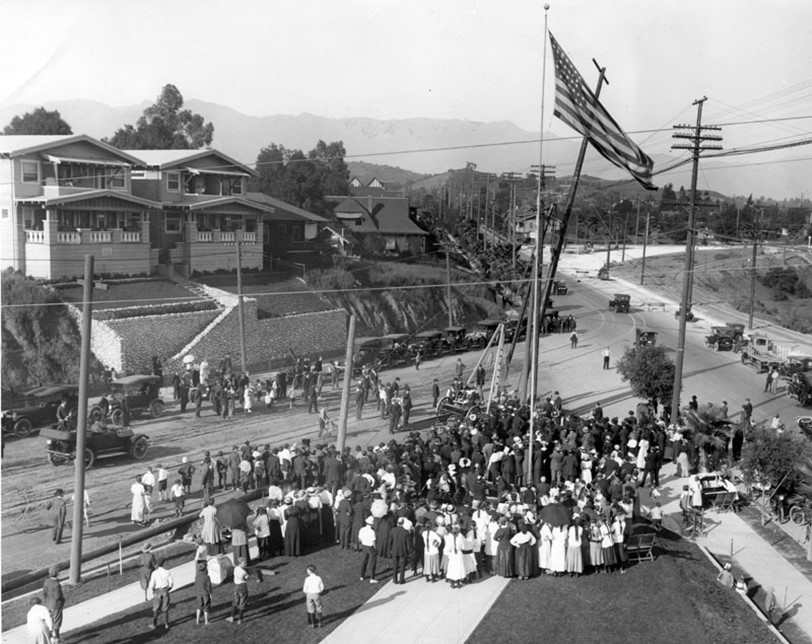 |
|
| On March 30, 1916, the raising of a single pole in Highland Park (pictured above) inaugurated a distribution system that within just 20 years would become the dominate electric utility business of Los Angeles. |
The first power supplied to the above distribution system came from a nearby power plant in Pasadena. However, just one year later, the Los Angeles Bureau of Power and Light had developed enough electric energy from its newly constructed power plants to sell its excess energy to Pasadena using these same lines.
What major power plant constructed by LA’s Bureau of Power and Light made this possible?
A) Hoover Dam Power Plant B) Scattergood Power Plant C) Valley Steam Plant D) San Francisquito Canyon Power Plant E) Haynes Steam Plant |
Bonus Points: Can you name the exact location of this intersection?
◆ _________________ & __________________ |
Click HERE for Answers and more background on Los Angeles' First Municipal Power Pole. |
* * * * * |
Mystery History Question (Oct. 2024)
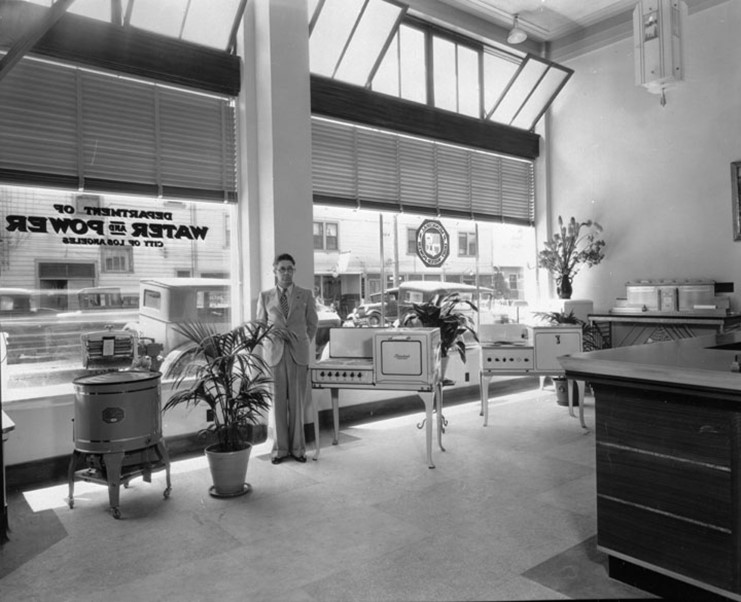 |
|
| A Department of Water and Power sales representative stands next to an electric range display at the Hollywood DWP Branch office located at 1613 North Cahuenga Boulevard. |
Little Known Fact: In the early 20th century, the Los Angeles Department of Water and Power (LADWP), then known as the Bureau of Power and Light, sold electrical appliances as part of a broader strategy to promote electricity use in the city. This practice, common among utility companies at the time, aimed to integrate electricity into the daily lives of residents and businesses, thereby establishing a steady demand for electric power.
Later, the Bureau of Power and Light consolidated with the Bureau of Water Works and Supply to form the Los Angeles Department of Water and Power, as we know it today.
What decade did this occur?
◆ 1910s ◆ 1920s ◆ 1930s ◆ 1940s ◆ 1950s |
Bonus points for the exact year:
◆ _________________ |
Click HERE for Answer For additional historical information on the DWP Branch Office shown in the image above, click HERE. |
* * * * * |
Mystery History Question (July 2024)
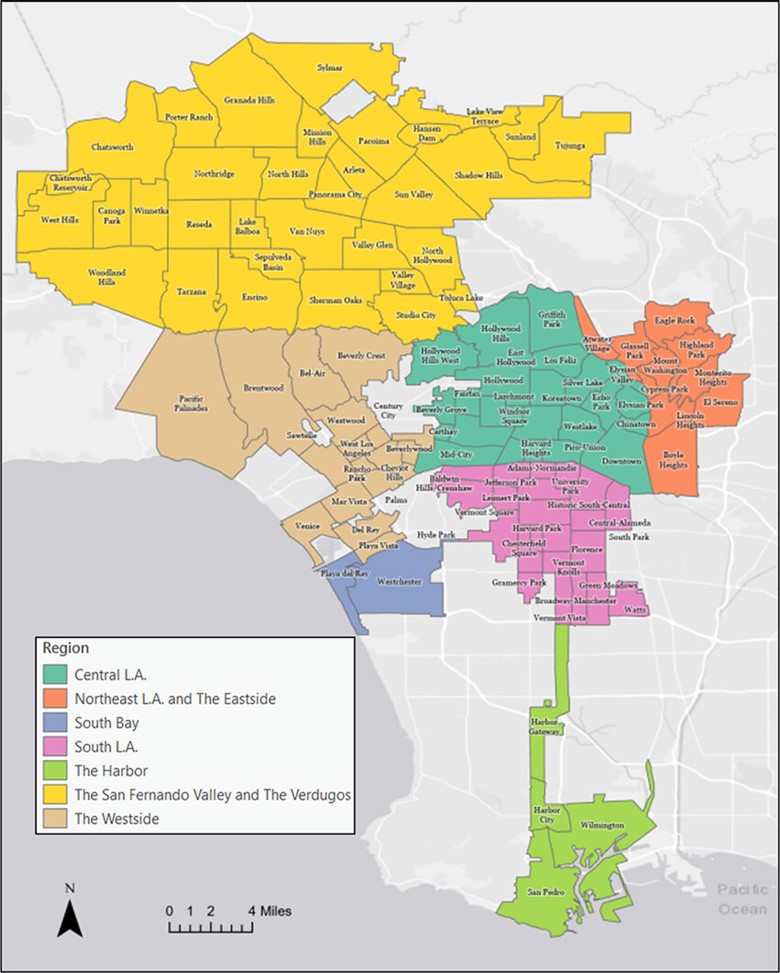 |
|
| Los Angeles, the second most populous city in the U.S., spans approximately 469 square miles, making it one of the largest cities by land area. This widespread urban expansion presents significant challenges in providing reliable water and electricity to millions of residents, necessitating complex infrastructure and continuous maintenance and upgrades. |
How many of the following major U.S. cities, combined, could fit within the geographical boundaries of Los Angeles?
◆ Boston ◆ Cleveland ◆ Manhattan ◆ Milwaukee ◆ Minneapolis ◆ Pittsburgh ◆ San Francisco ◆ St. Louis |
Click HERE for Answer |
* * * * * |
Mystery History Question (April 2024)
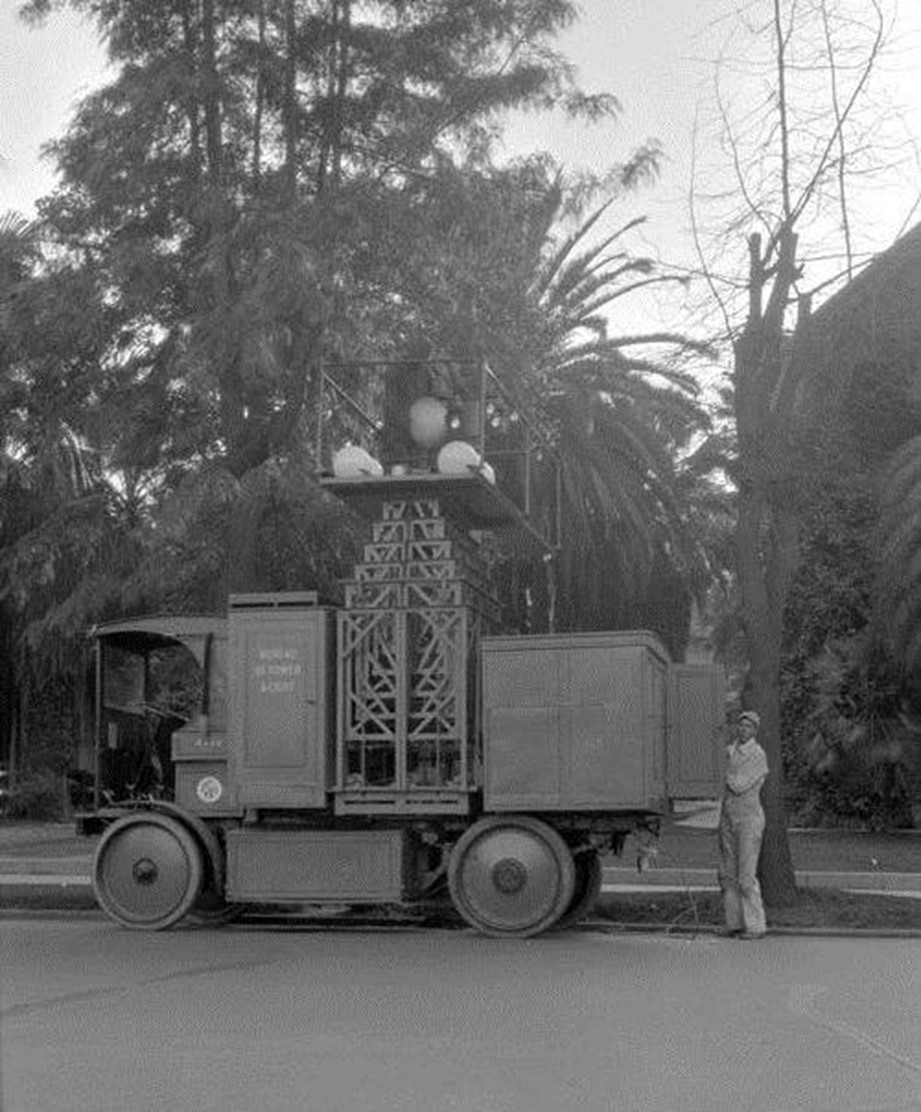 |
|
| This 1920s photo shows a Bureau of Power and Light electric powered streetlight truck parked by the curb with a maintenance worker standing behind it. Note all the replacement globes on top of the truck's extension platform. |
The Bureau of Power and Light merged with the Bureau of Water Works to become today’s Los Angeles Department of Water and Power (LADWP). What year did this happen?
A) 1927 B) 1937 C) 1947 D) 1957 E) 1967 |
That same year the LADWP acquired the power system of another utility operating and selling power within the city. This acquisition solidified LADWP's position as the sole power service provider in Los Angeles. What is the name of the other utility?
A) Los Angeles Edison Electric B) Southern California Edison C) Pacific Light and Power Company D) Los Angeles Gas and Electric Corporation E) West Side Lighting Company |
Click HERE for Answers |
* * * * * |
Mystery History Question (January 2024)
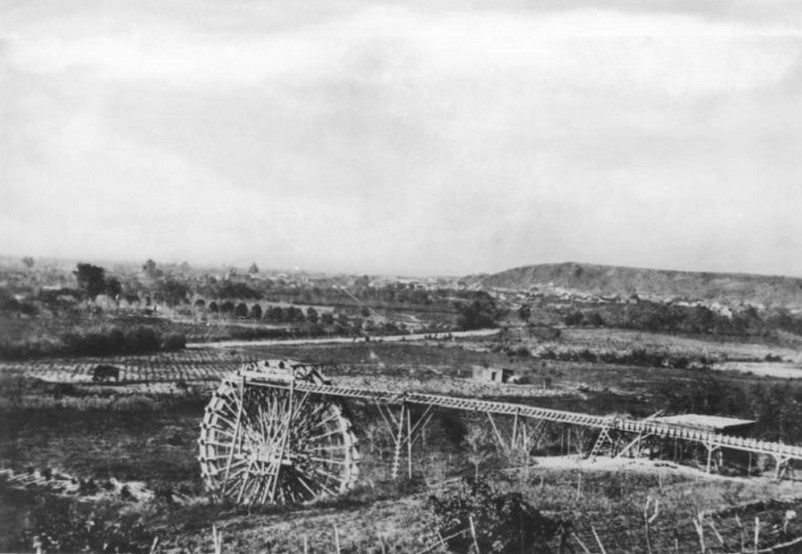 |
|
| The 40 ft. water wheel seen above was used to raise a portion of the Los Angeles River water supply to a height permitting gravity flow to homes, fields and storage. |
Which of the following men originally built this water wheel? He was granted a franchise by the City Council to construct a water system for the early inhabitants of Los Angeles.
A) Prudent Beaudry B) William Dryden C) John S. Griffen D) Damien Marchessault E) Jean L. Sainsevain |
What year was the original water wheel constructed?
A) 1847 B) 1857 C) 1867 D) 1877 E) 1887 |
Click HERE for Answers |
* * * * * |
Mystery History Question (October 2023)
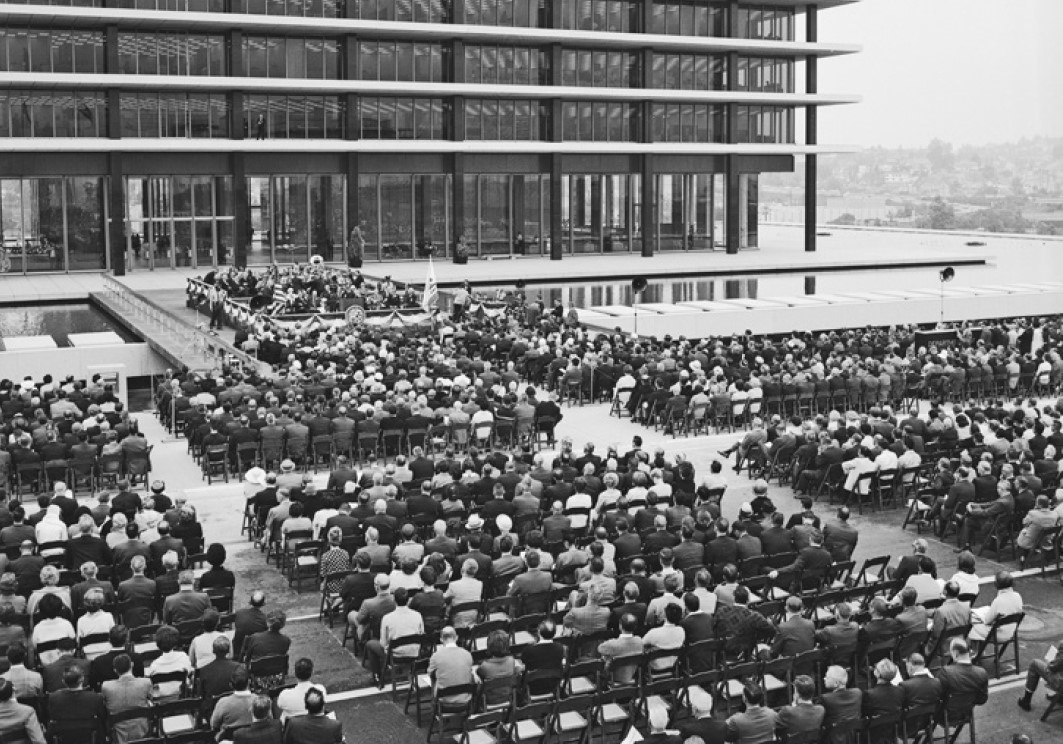 |
|
| This June 24, 1965 photo shows the opening ceremony for DWP's General Office Building located at 111 N. Hope Street in downtown Los Angeles. |
As part of the ceremony the eight fountains outside the building were turned on by granddaughters of the two men who were DWP's first chief engineers.
Name DWP's first two chief engineers?
____________________________________ & ____________________________________
Click HERE for Answers |
* * * * * |
Mystery History Question (July 2023)
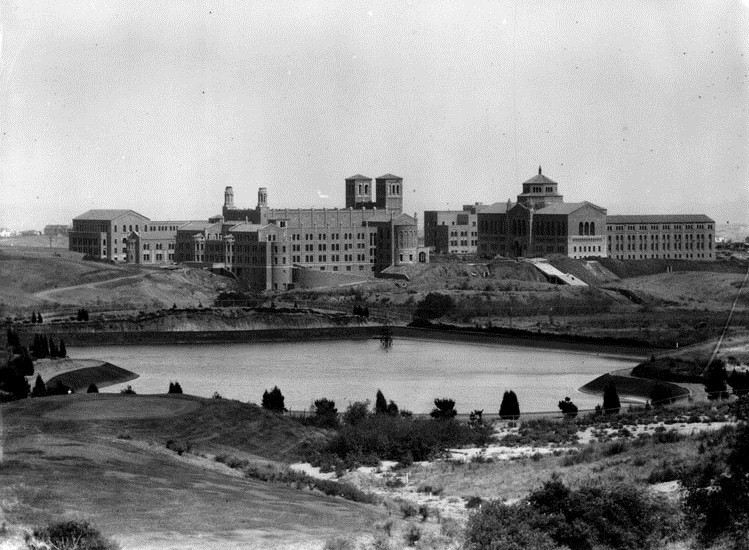 |
|
| This 1929 photo shows a large body of water located near the recently completed UCLA campus. View is looking southeast. The lake-like reservoir was installed by the Los Angeles Bureau of Water Works & Supply (later LADWP) in 1924. |
The reservoir seen above was used until at least the 1960s when it was replaced by a large underground storage tank installed nearby. What was the name of this now forgrotten water reservoir?
A) Bel Air Reservoir B) Sawtelle Reservoir C) University Reservoir C) West LA Reservoir D) Westwood Reservoir |
What is there today where this scenic reservoir once existed?
A) UCLA Parking Structure B) UCLA Intramural Fields C) Marymount High School D) Bel Air Golf Course |
Click HERE for Answer |
* * * * * |
Mystery History Question (April 2023)
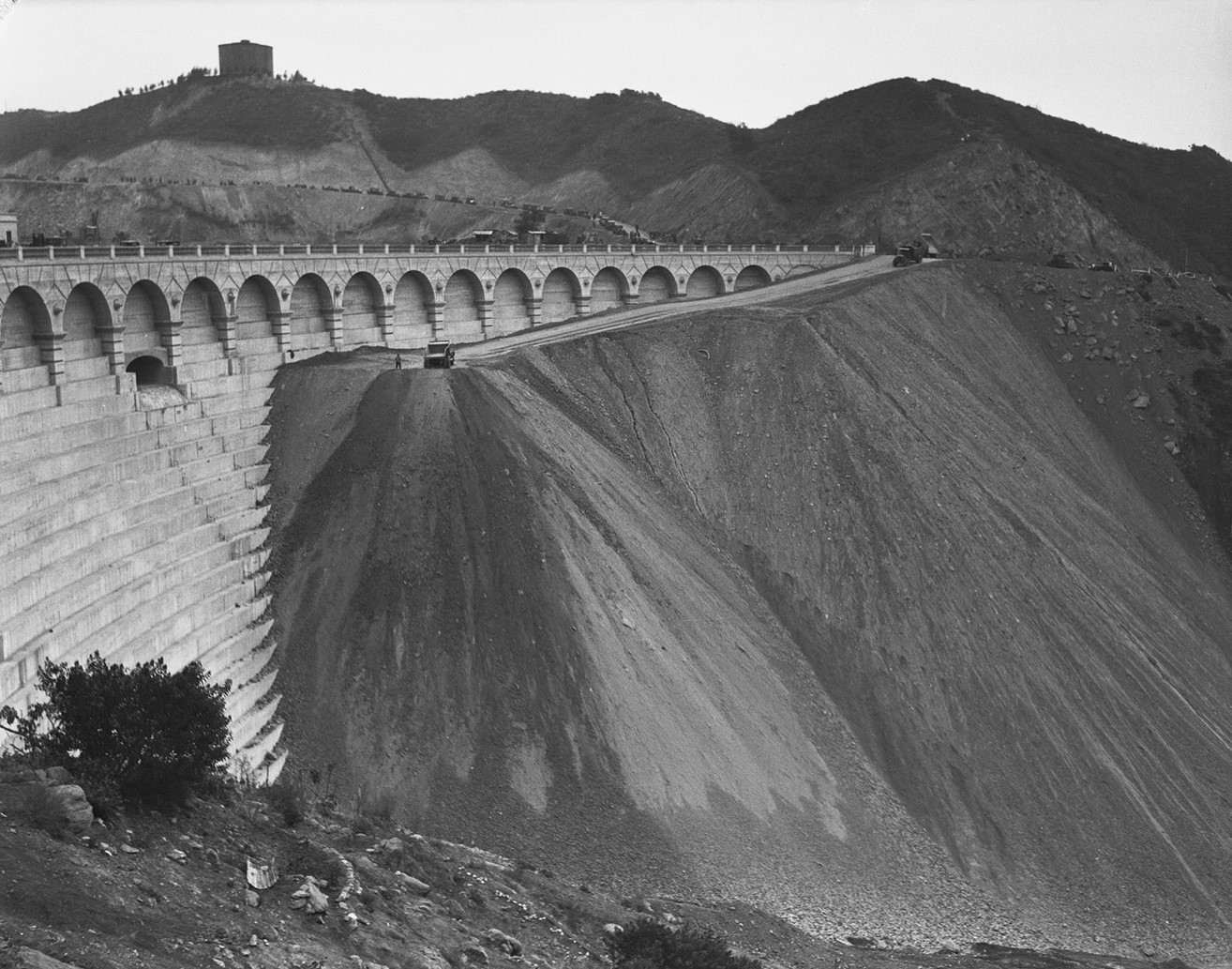 |
|
| The above 1929 photo shows a dam being reinforced by adding tons of earth on the downstream side as a precaution shortly after a similar dam failed catastrophically. The dam and water reservoir/lake behind it are still in use today. |
Name the dam and reservoir/lake in the above picture (hint: their location is within the LA City limits):
____________________________________ & ____________________________________
Click HERE for Answer |
* * * * * |
Mystery History Question (January 2023)
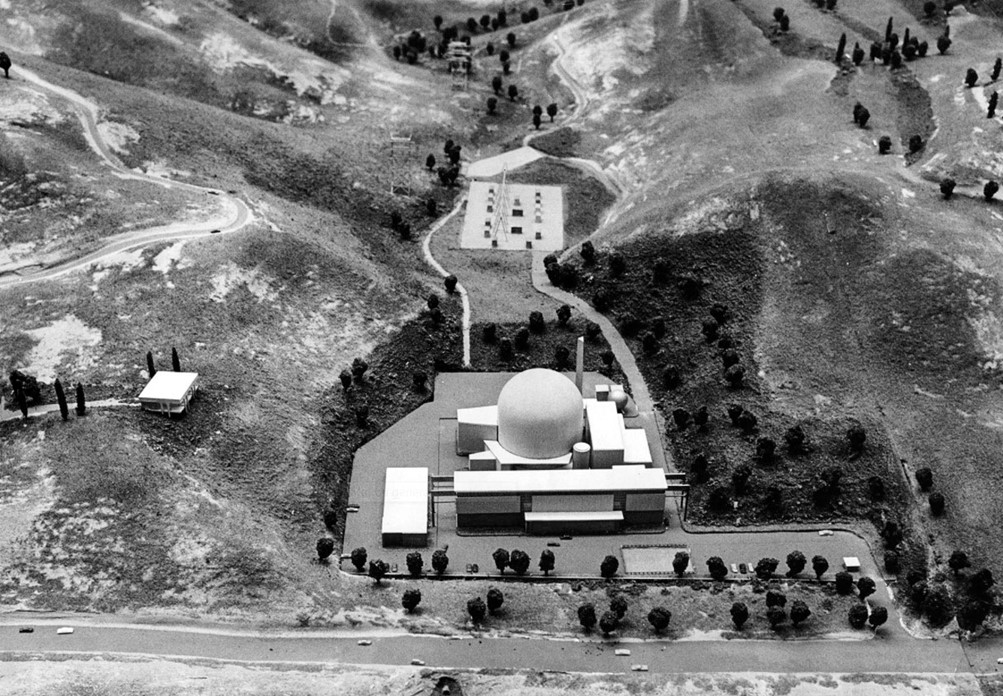 |
|
| Photo showing a model of a proposed nuclear power plant to be built near Los Angeles. This photo appeared in the June 21, 1965, edition of the Los Angeles Times. |
Historical Background DWP engineers viewed nuclear power as the perfect solution to a looming electricity shortage. The proposed plant would be larger than any atomic plant in existence and would have the capacity to generate about 20 percent of the power for every home, office and factory in Los Angeles, the agency predicted. The federal Atomic Energy Commission was willing to classify the new reactor as a nuclear power demonstration project. As such, the commission would pay a large percentage of the costs for the design of the plant and would waive fuel-use charges for years. City officials thought that the atomic plant plan would sail through federal and local reviews. In 1963, they entered into a tentative agreement with the Westinghouse Corp. to buy the generating equipment. The Atomic Energy Commission named a Boston company to design and build the reactor. Officials announced that the plant would be completed by 1967. |
What was the proposed location of this nuclear power plant?
A) San Luis Obisbo B) Oxnard C) Malibu D) Santa Monica E) Huntington Beach |
Click HERE for Answer |
* * * * * |
Mystery History Questions (October 2022)
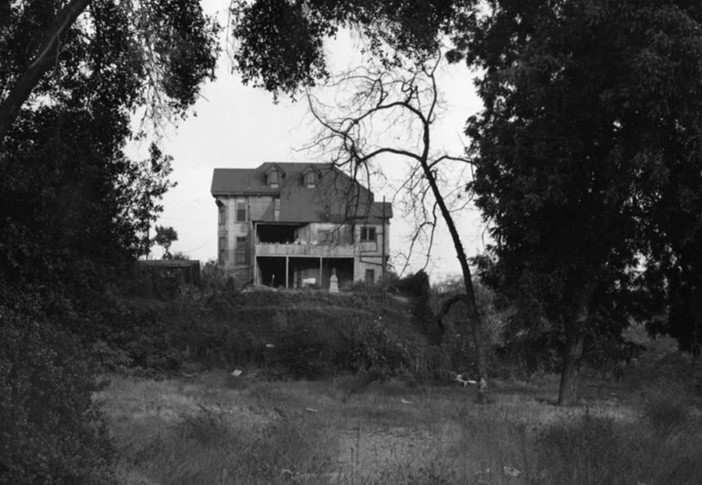 |
|
| This 1950s photo shows the Basserman home located on Bunker Hill at the current location of the Water and Power Building (John Ferraro Office Building). What appears to be a figure in white on the porch is not a woman, nor a ghost. It’s an incinerator. |
What year was the Water and Power Building built?
A) 1955 B) 1960 C) 1965 D) 1970 E) 1975 |
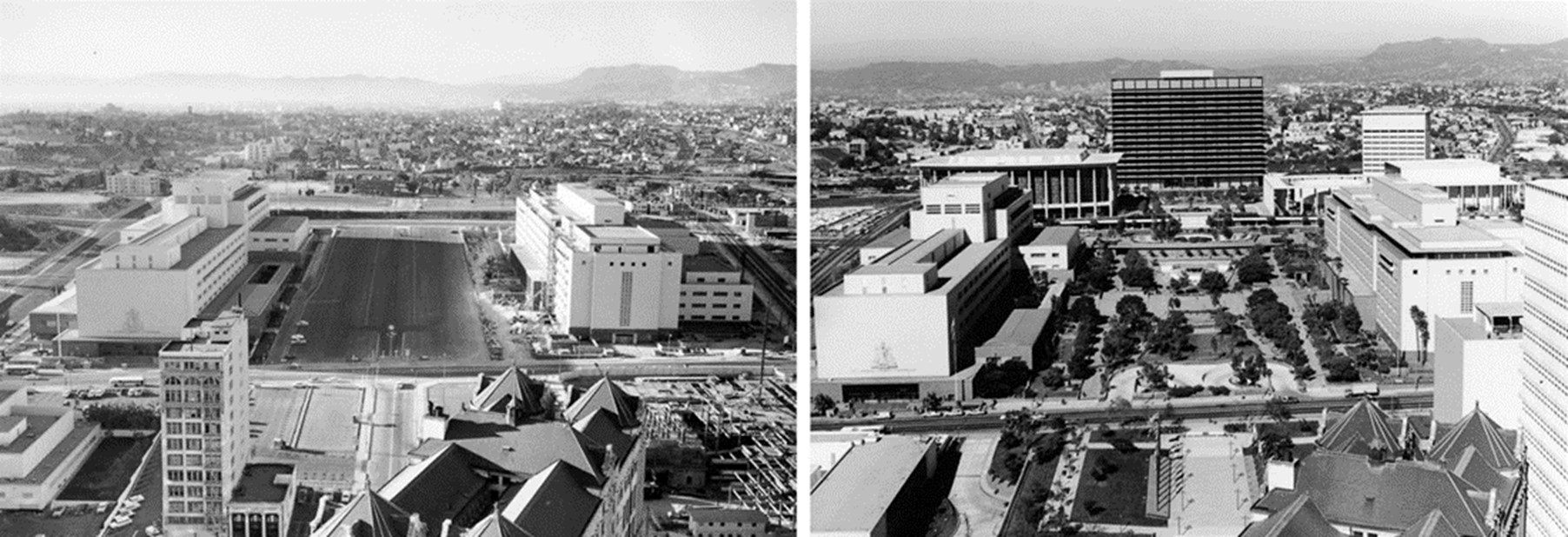 |
|
| Before and After – View looking toward Bunker Hill as seen from the top of City Hall. |
Little Known Fact: The Water and Power Building was originally designed to be 20 stories tall. Things would change after the City politicians discovered that the new building would effectively be higher then the 28-story LA City Hall (mainly because it sat on Bunker Hill). It turns out that the iconic building wasn’t built to it’s original designed height and therefore City Hall continued to be the tallest building in the Civic Center.
How many stories is the DWP building? ___________________________
Click HERE for Answers |
* * * * * |
Mystery History Question (July 2022)
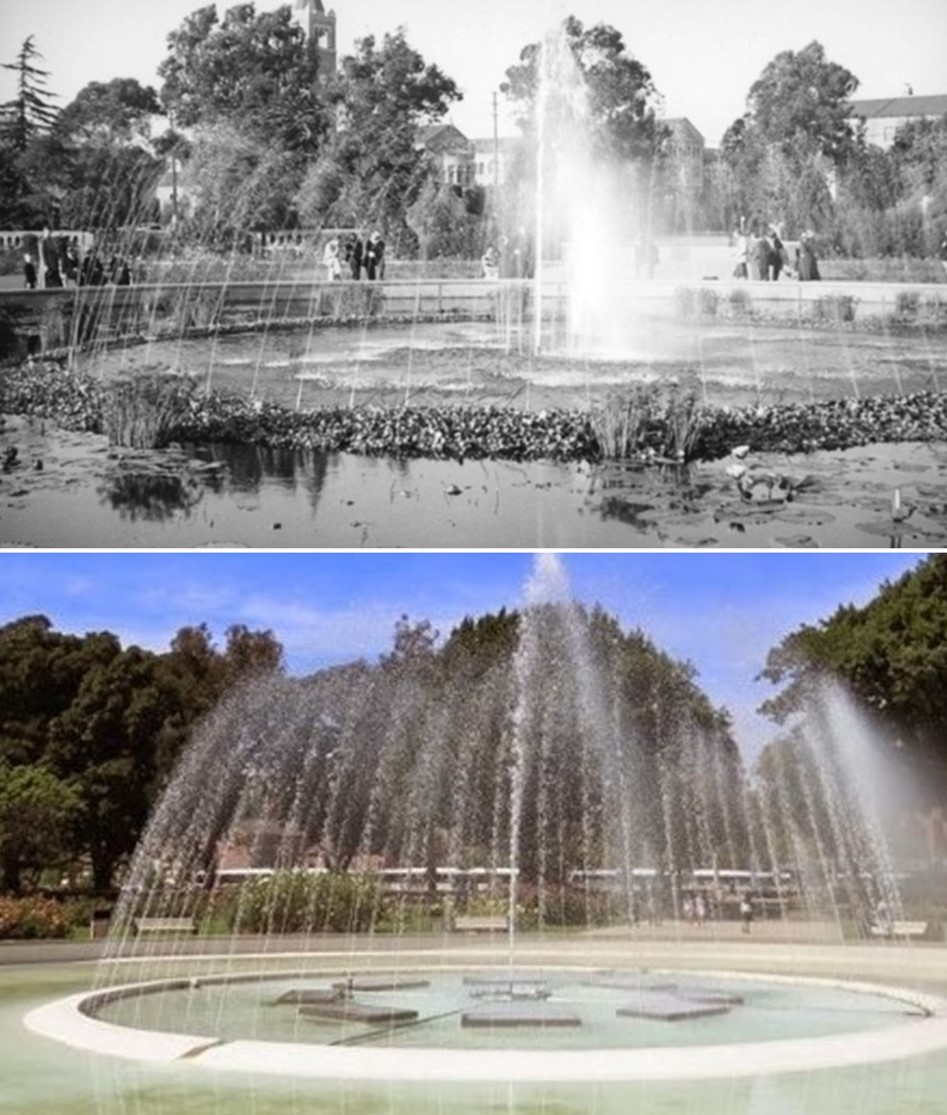 |
|
| Then and Now - Jets of water converge in the center of a fountain situated in the center of the gardens in this well known Los Angeles Park. The fountain (and park) was dedicated on November 6th, 1913. Symbolically, it represents the terminus of the new LA Aqueduct, opened a day earlier on November 5th, 1913. |
Can you name this well known Los Angeles Park? _________________________________________
Click HERE for Answer |
* * * * * |
Mystery History Question (April 2022)
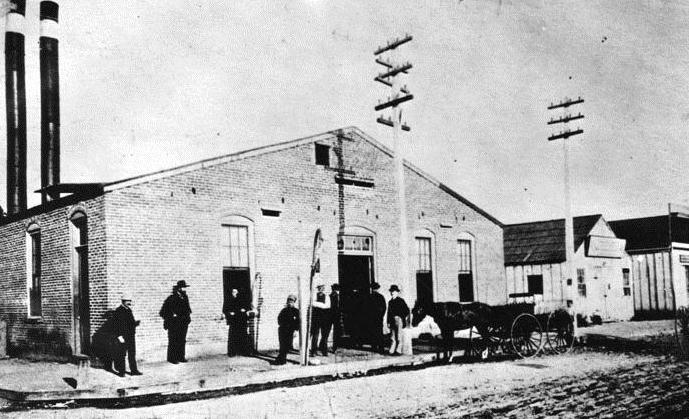 |
|
| The above photo shows Los Angeles’ first power plant. It was located on the corner of Alameda and Banning streets in downtown, just six short blocks south of the Los Angeles Plaza. Charles L. Howland and several other investors built this plant when they formed LA’s first electric utility. |
When was the above power plant built?
A) 1863 B) 1873 C) 1883 D) 1893 E) 1903 |
What was the name of LA's 1st electric utility?
A) Los Angeles Electric Company B) Pacific Light and Power Company C) West Side Lighting Company D) Southern California Edison E) LA Gas and Electric Corporation |
Click HERE for Answers |
* * * * * |
Mystery History Question (Jan 2022)
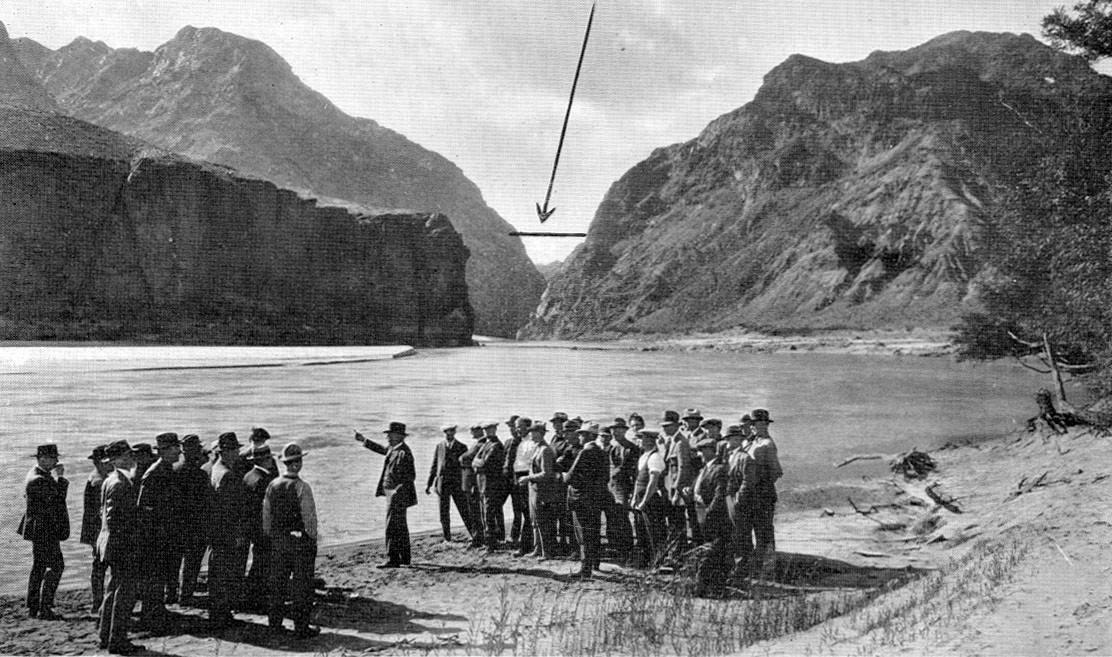 |
|
| William Mulholland (center) outlines to a group of Southern California officials the necessity and benefits of a high dam at the above location shown by arrow and line. |
When was the above photo taken?
A) 1920 B) 1925 C) 1930 D) 1935 E) 1940 |
Name the dam:
A) St. Francis Dam B) Mulholland Dam C) Hoover Dam D) Parker Dam E) Havasu Dam |
Click HERE for Answers |
* * * * * |
Mystery History Question (October 2021)
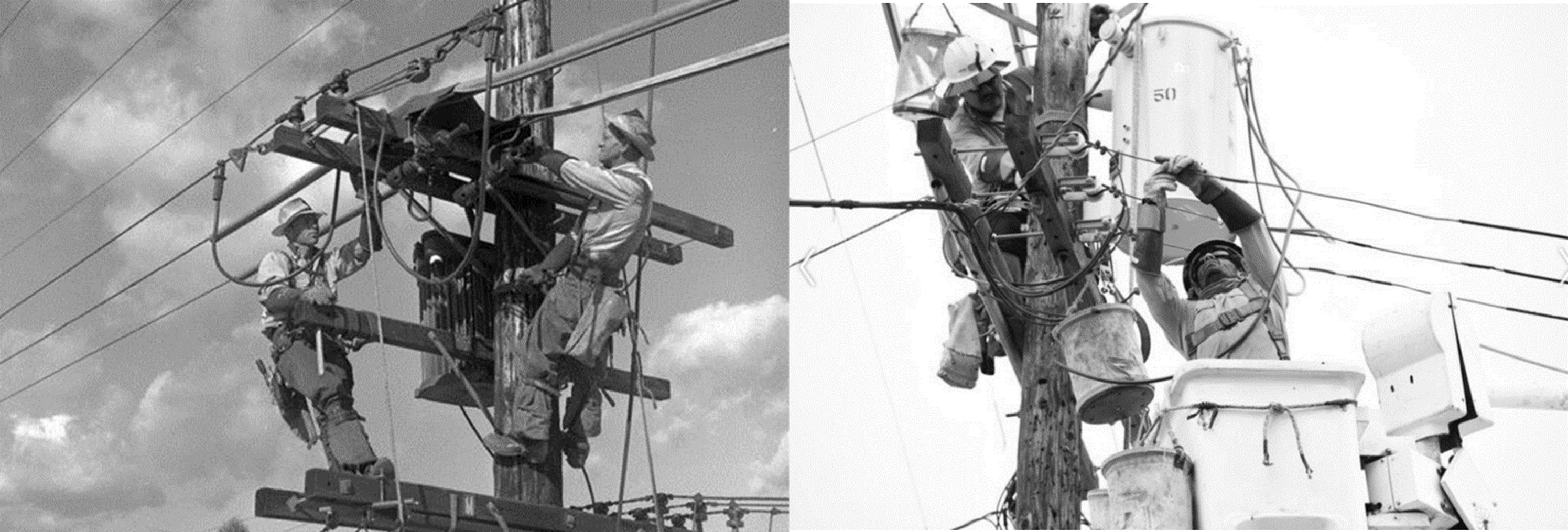 |
|
| The picture on the right shows DWP linemen working on energized lines in 2019. On the left can also be seen DWP linemen working on energized lines. |
What decade was the picture on the left taken?
A) 1930s B) 1940s C) 1950s D) 1960s E) 1970s F) 1980s |
What are some of the things that have changed between then and now?
-------------------------- -------------------------- -------------------------- -------------------------- |
Click HERE for Answers |
* * * * * |
Mystery History Question (July 2021)
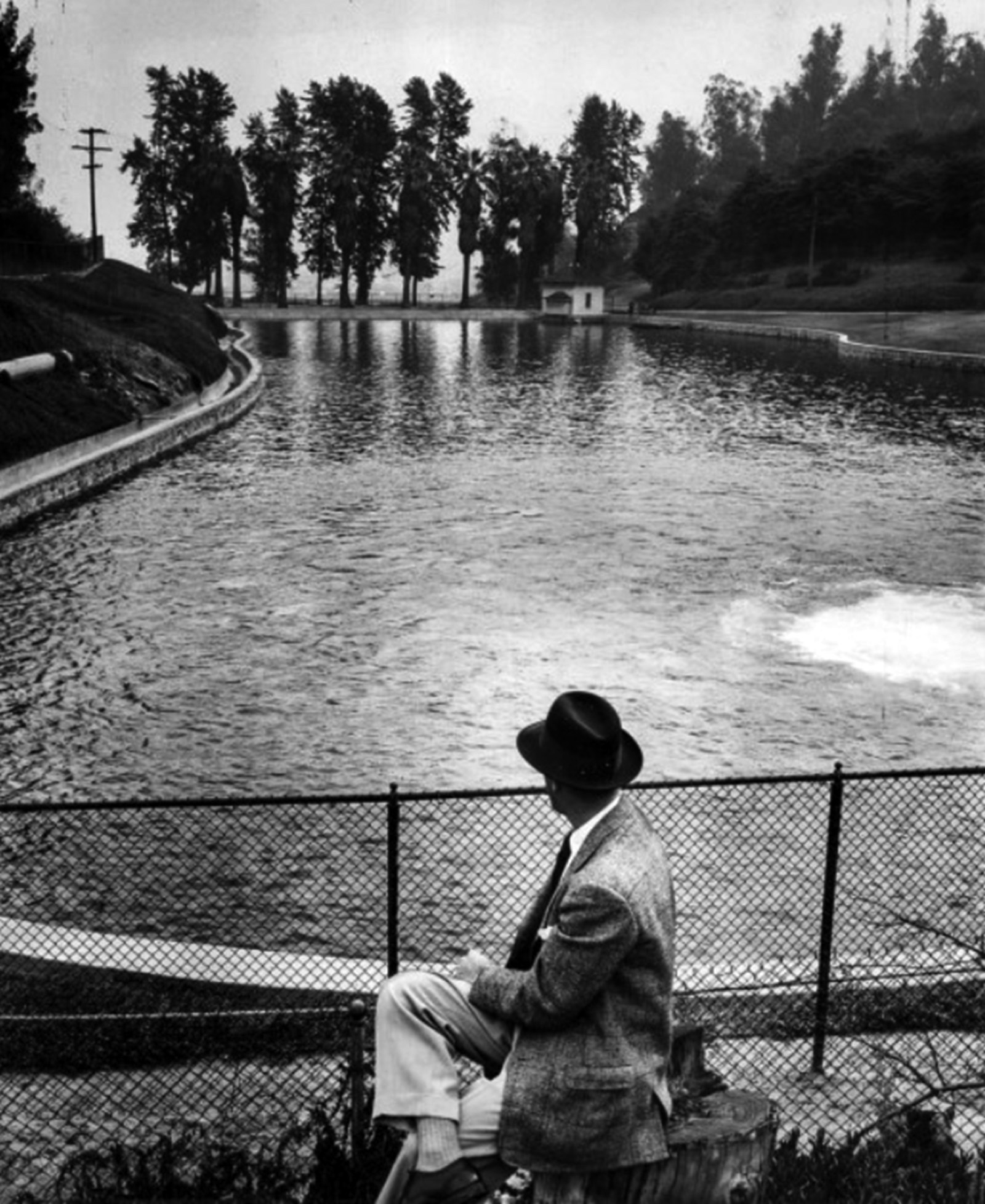 |
|
| A man looks out towards a fenced-in large body of water. This was LA’s first large scale water reservoir and served the City for over 87 years. The reservoir was taken out of service a year after this photo was taken. |
Name this well known historic water reservoir:
A) Elysian Reservoir B) Sliver Lake Reservoir C) Buena Vista Reservoir D) Mulholland Reservoir E) Echo Park Reservoir |
What year was it built?
A) 1851 B) 1869 C) 1887 D) 1905 E) 1923 |
Click HERE for Answers |
* * * * * |
Mystery History Question (April 2021)
.jpg) |
|
| The above photo was taken in 1860. It shows one of LA’s first above ground water reservoirs that was located at center of the LA Plaza. The dirt road seen at upper-left is now known as Olvera Street (Originally Wine Street). |
Who built this large brick and wooden water storage tank?
A) William Dryden B) Prudent Beaudry C) Jean Sainsevain D) David Alexander E) Damien Marchessault |
For how many years was this structure used before being dismantled?
A) 5 B) 10 C) 15 D) 20 E) 25 |
Click HERE for Answers |
* * * * * |
Mystery History Question (Jan 2021)
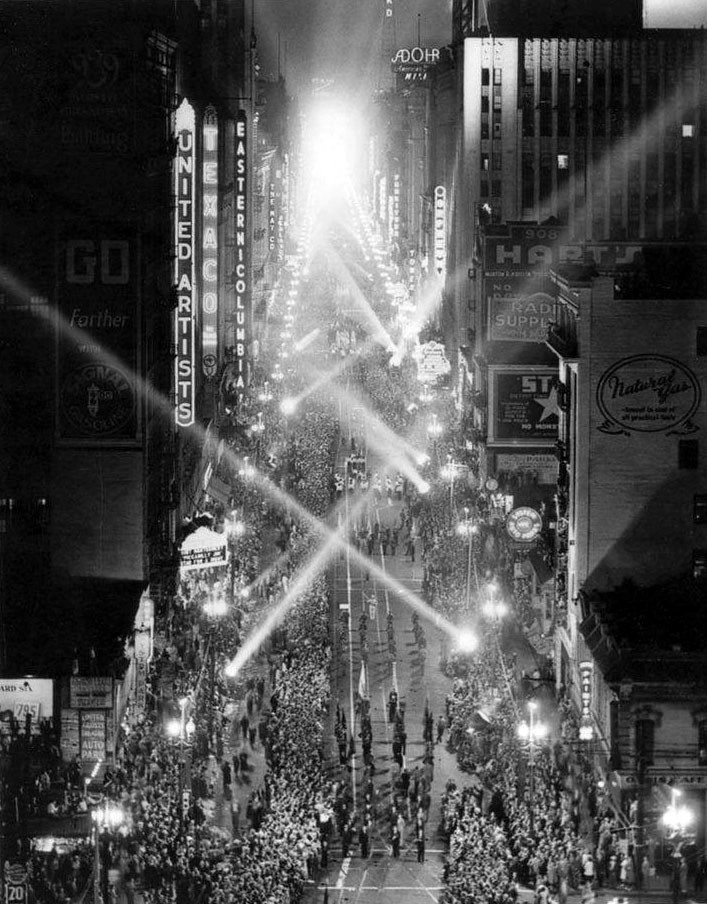 |
|
| This 1936 photo shows a parade down Broadway (aka "The Light on Parade") celebrating Los Angeles' new source of electricity after the completion of Hoover Dam. |
Historical Notes An October 10, 1936 article in the Los Angeles Times describes the scene as follows: "Astride the power of 115,000 horses, with burning plumes outspread, the Giant of Hoover Dam–Electricity–rode into Los Angeles last night, casting a heretofore unseen and magnificent glare on more than 1,000,000 persons who crowded the downtown district from end to end. |
Little known fact: When Hoover Dam began transmitting electricity to Los Angeles in 1936 it delivered 70% of Los Angeles’ power.
What percentage does it deliver today?
A) 5% B) 10% C) 20% D) 30% E) 40% F) 50% |
Click HERE for Answers |
* * * * * |
Mystery History Question (Oct 2020)
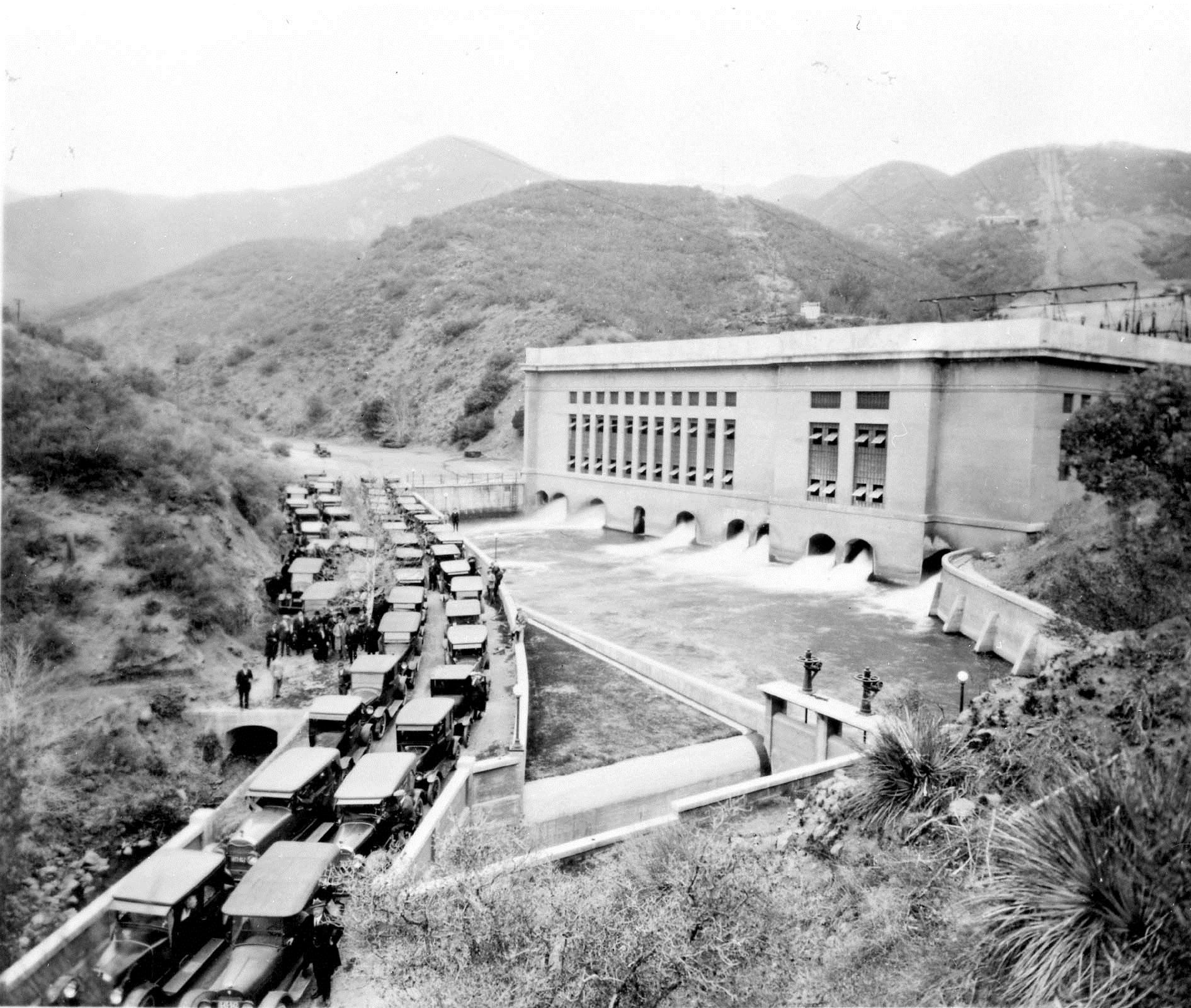 |
|
| The above 1917 image shows the opening ceremony of the 1st major hydro power plant that would be operated by the Los Angeles Bureau of Power and Light (later LADWP). |
Historical Notes Once the Los Angeles Aqueduct was completed in 1913, it became possible to harness the newly delivered water and use it to generate electricity. This was the 1st major hydro power plant that would provide Los Angeles with much of its power needs for years. Astonishingly, the plant still exists today and delivers clean energy to Angelinos over 100 years after it was originally built. |
Name the Power Plant:
A) Cottonwood Power Plant B) Division Creek Power Plant C) Foothill Power Plant D) San Fracisquito Power Plant E) Franklin Power Plant F) Sawtelle Power Plant |
When first opened in 1917, this power plant provided over 70% of LA’s power needs. What percentage of LA’s power does it provide today?
A) 0.5% B) 1.0% C) 1.5% D) 2.0% E) 2.5% F) 3.0% |
Click HERE for Answers |
* * * * * |
Mystery History Question (July 2020)
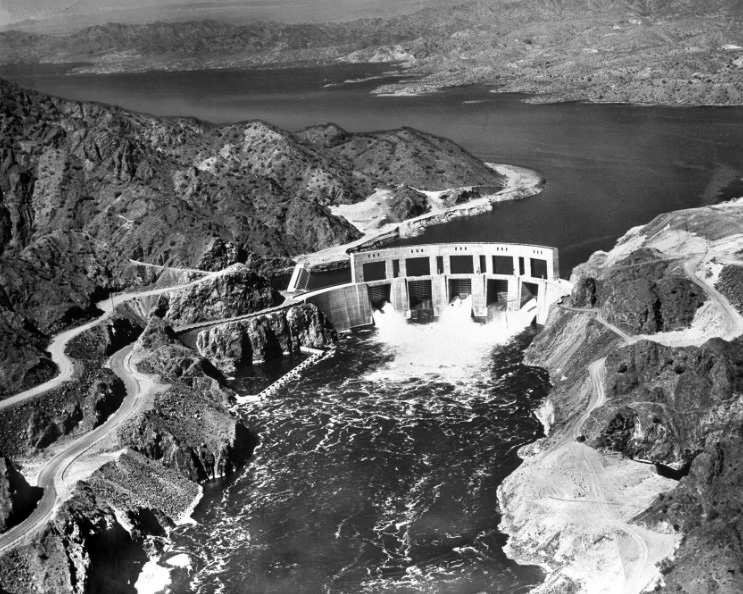 |
|
| The above image shows a one-of-kind dam known as “the deepest dam in the world”, mainly because it extends 247 feet below the water bed. It’s primary purpose was to create a reservoir, seen behind it, that today provides up to 60% of Southern California’s water supply. |
What is the name of the dam?
A) Oroville Dam B) Parker Dam C) Shasta Dam D) New Melones Dam E) New Bullards Bar Dam |
It took over 5 years to construct this dam. In what decade was it built?
A) 1920s B) 1930s C) 1940s D) 1950s E) 1960s F) 1970s |
Click HERE for Answers |
* * * * * |
Mystery History Question (April 2020)
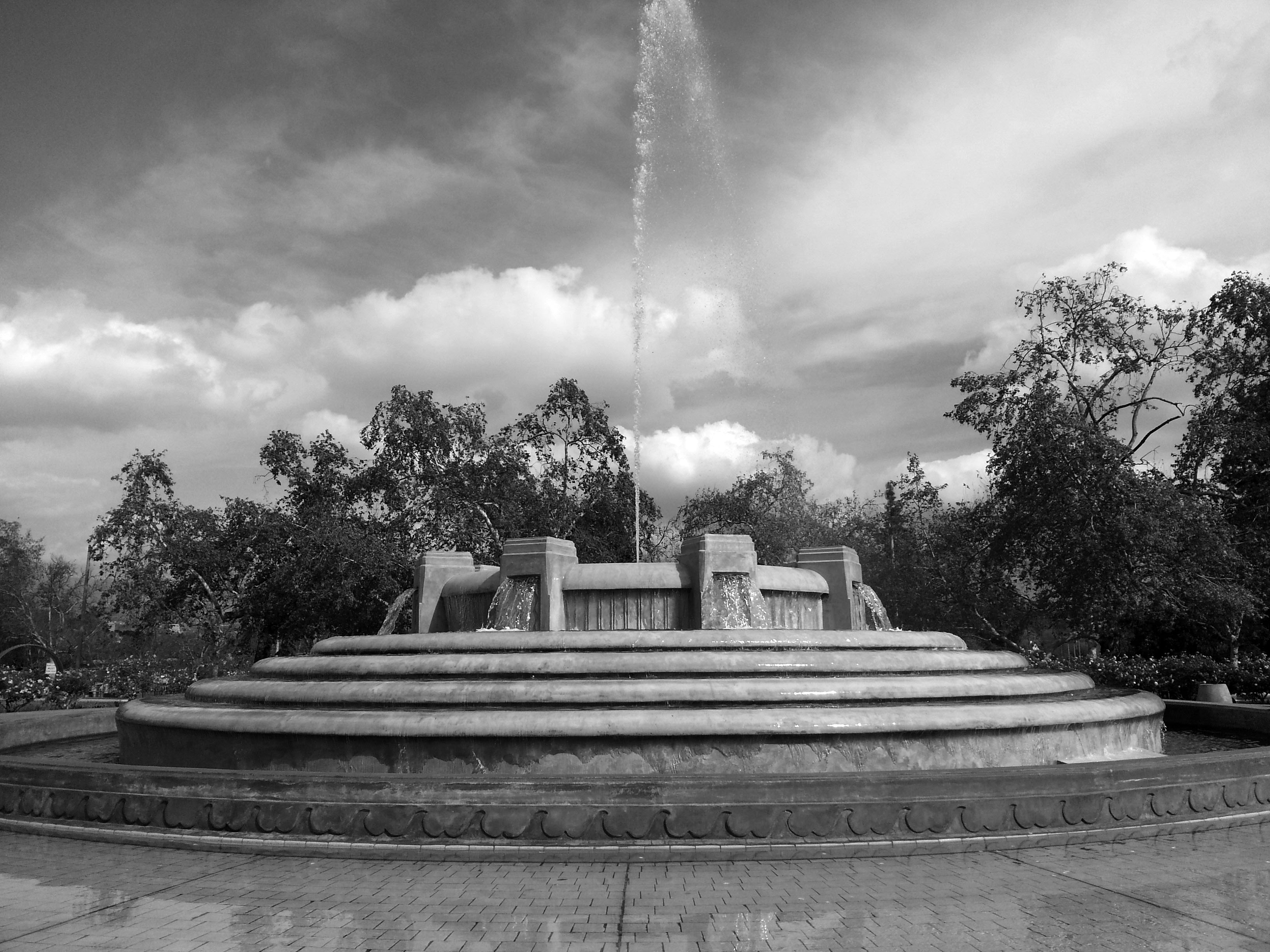 |
|
| At the corner of Riverside Drive and Los Feliz Boulevard in Los Feliz, spitting distance from the Los Angeles River, you’ll find a shrine to the “Father” of L.A.’s water system, William Mulholland – built approximately on the site where Mulholland once lived in a cabin, worked as a water laborer (technically a ditch-tender) and taught himself to be a civil engineer. |
What year was the Mulholland Fountain built?
A) 1920 B) 1930 C) 1940 D) 1950 |
True or False?
The following were also named for William Mulholland: |
True |
False |
◆ Mulholland Dam ◆ Mulholland American Whiskey ◆ Liberty Ship S.S. Mulholland ◆ Mulholland Theatre ◆ Mulholland Town ◆ Mulholland Highway ◆ Mulholland Drive ◆ Mulholland Middle School ◆ Mulholland Military Academy ◆ Mulholland Pump Station ◆ Mulholland Virtual Museum |
Click HERE for Answers |
* * * * * |
Mystery History Question (October 2019)
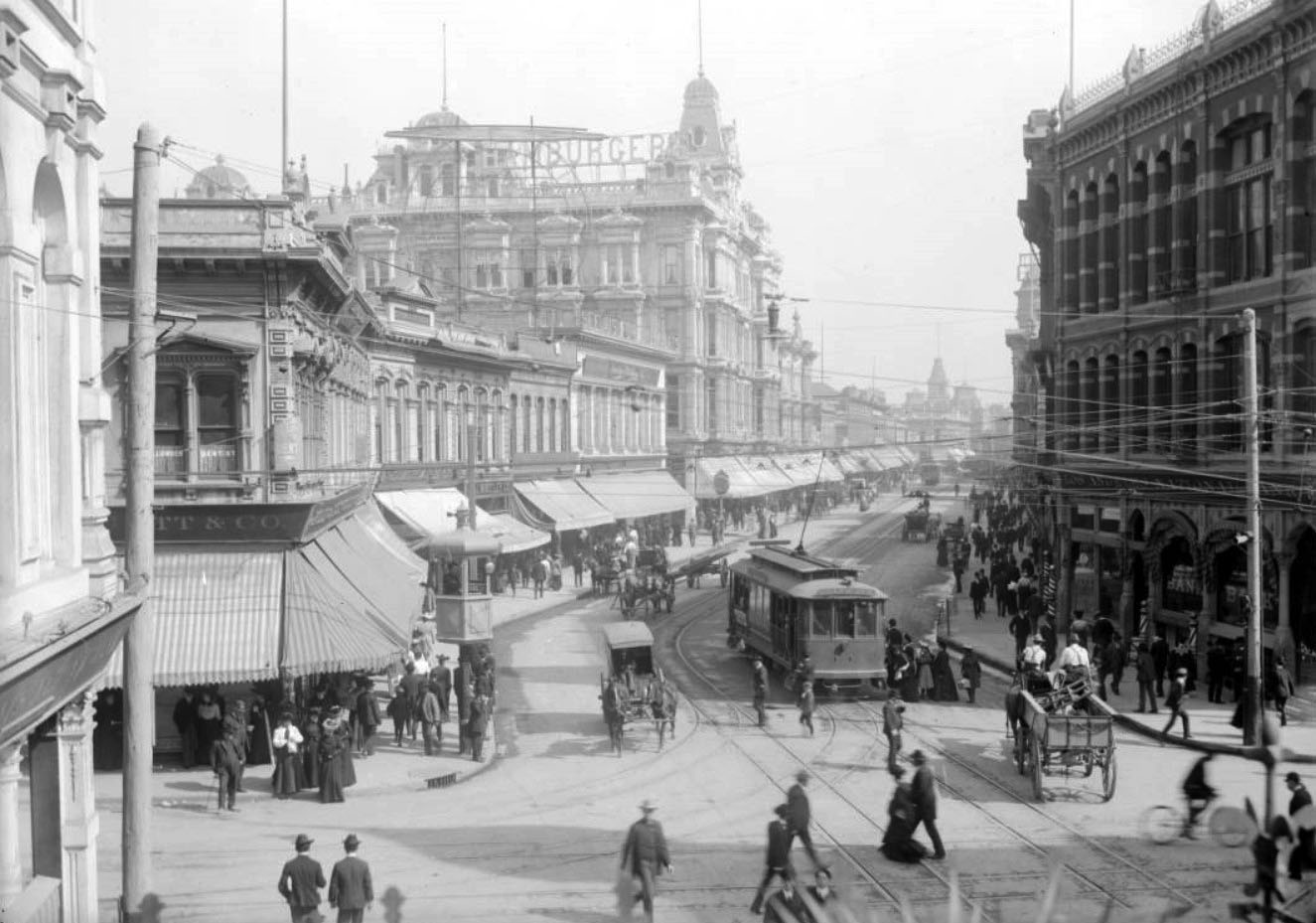 |
|
| This 1890s view, looking NE, shows a busy downtown Los Angeles intersection where horse-drawn carriages are seen sharing the road with electric streetcars, cyclists and pedestrians. On the SW corner (lower-left) is the Nadeau Hotel, LA's 1st four-story building (built in 1882). Further down the block can be seen another four-story ornate building. This was one of LA's 1st department stores called Hamburger & Son's People's Store. It later would evolve into the May Company Department Store. Today several well-known iconic buildings can be found in this area. |
What intersection are we looking at?
A) Olive and 3rd Streets B) Broadway and 7th Street C) Spring and 1st Streets D) Figueroa and Adams Boulevard E) Temple and Hill Streets |
Click HERE for Answer |
* * * * * |
Mystery History Question (July 2019)
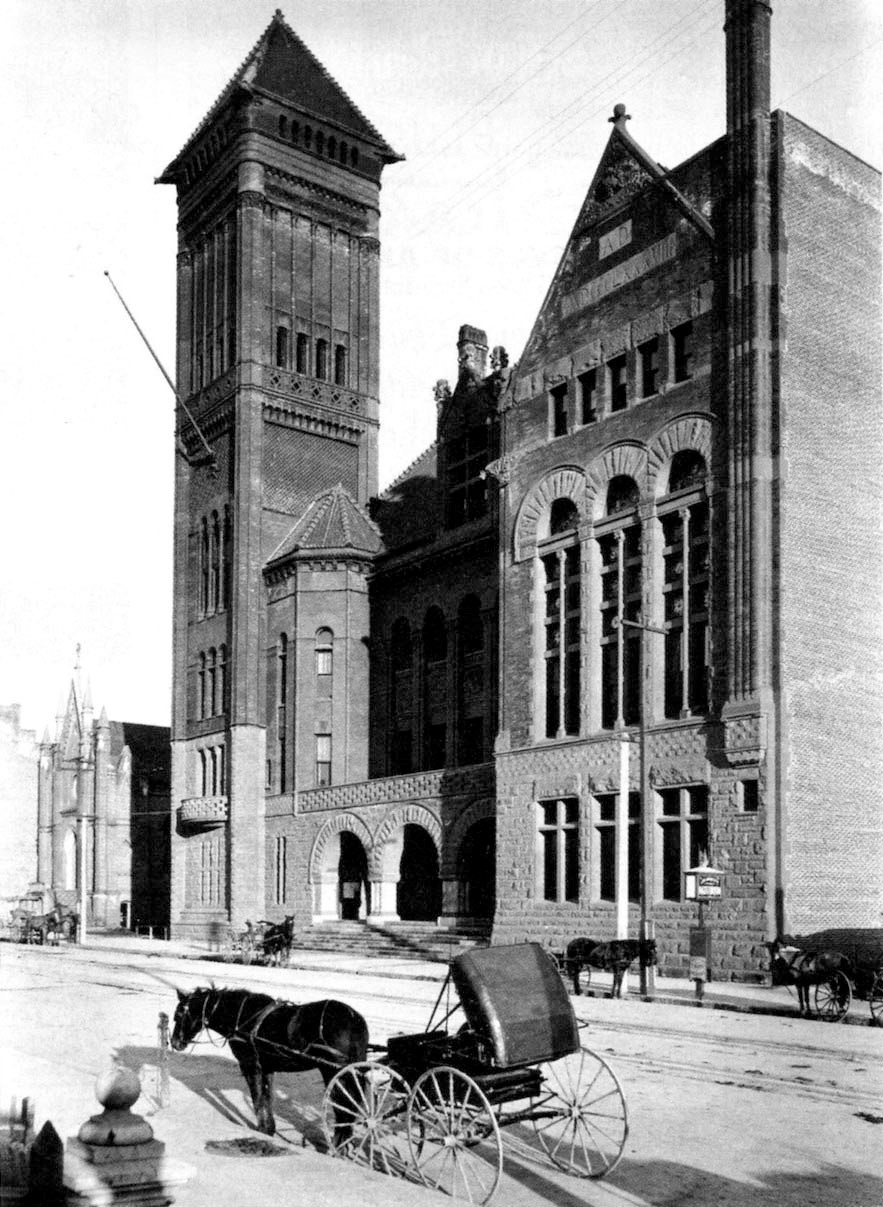 |
|
| View looking NE showing horse-drawn carriages parked along the curb of an unpaved Broadway. Across the street is a large ornate building with a buttressed skyscraper tower atop a square colonnade base. The building has a wide three-arched porch accessed by a broad flight of stone steps, numerous large windows throughout, and a gabled roof. |
Historical Notes This grand Romanesque edifice building was made of marble and red sandstone. Built in 1888, the building stood for 40 years on the 200 block of South Broadway in Downtown Los Angeles. The skyscraper tower could be seen for miles. |
What was the name of the building?
A) LA County Courthouse Building B) LA Water Department Building C) LA City Hall Building D) LA Gas and Electric Building E) Federal Building and Post Office |
Click HERE for Answer |
* * * * * |
Mystery History Questions (April 2019)
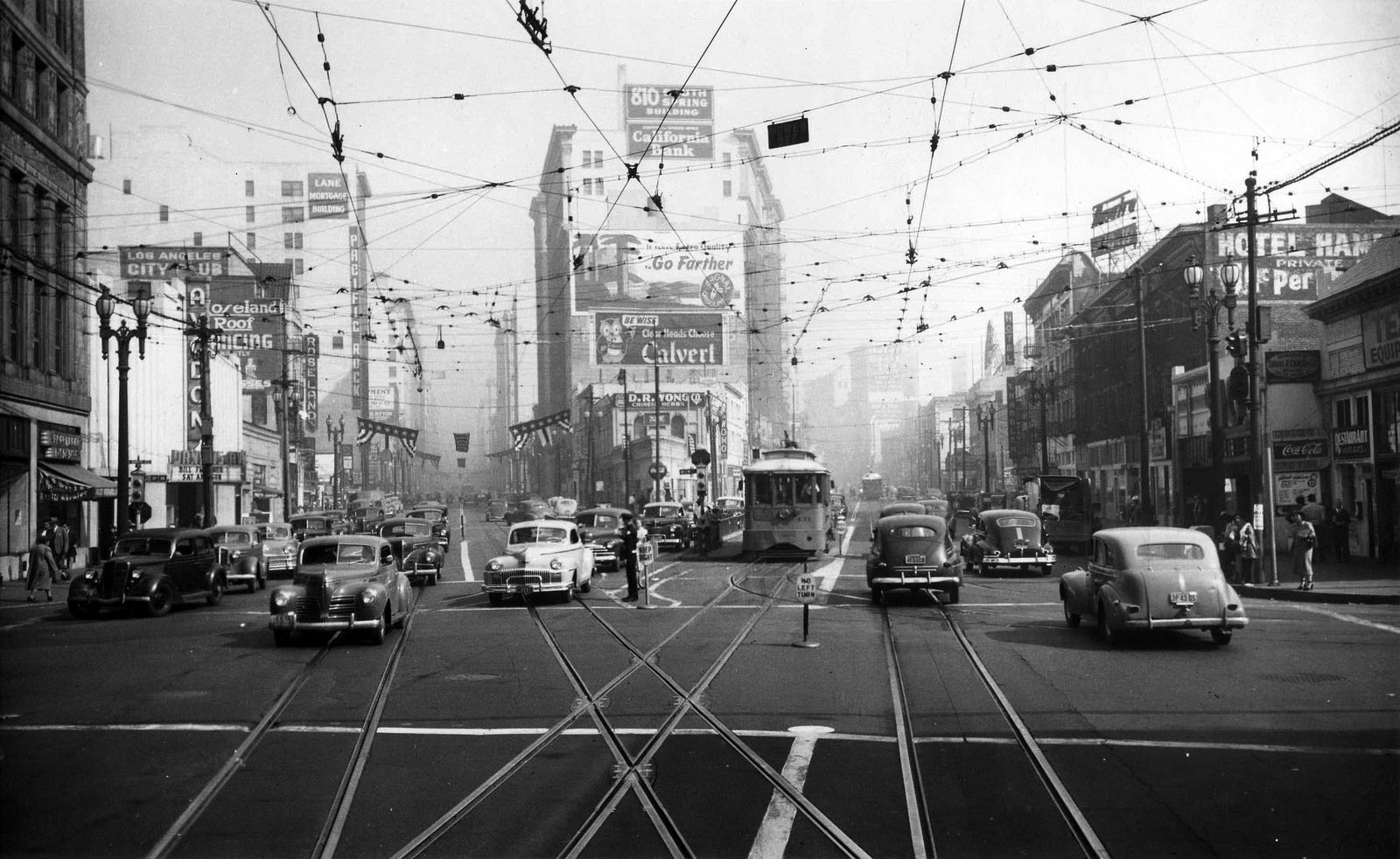 |
|
| Los Angeles Scene: This 1948 image shows a traffic officer standing in the middle of a busy intersection where three major streets converge. This historic Downtown Los Angeles intersection is similar in many ways to the more famous Latham Square in Oakland or even Times Square in Manhattan. |
Historical Notes Nearly 100 years before the above photo was taken, the land adjacent to this intersection was owned by one of the wealthiest man in Los Angeles who made his fortune by building an extension of the Zanja Madre, a canal system to bring water to the fields south of the pueblo. He was paid in land in that area – all now within present day Downtown Los Angeles. |
What are the names of the 3 streets that converge at this intersection?
__________________________ , __________________________, __________________________
What is the name of this well-known public figure who once owned most of the land around the above intersection?
A) William Mulholland B) Fred Eaton C) Chevy Chase D) Ozro Childs E) Isaias Hellman F) Robert Widney |
Click HERE for Answers |
* * * * * |
Mystery History Question (January 2019)
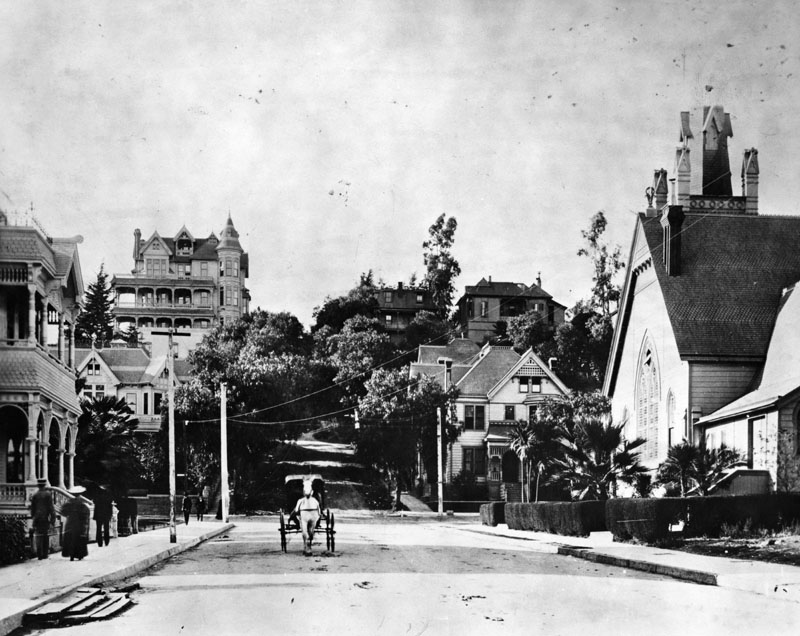 |
|
| Los Angeles Scene: This 1885 image shows a horse-drawn wagon on a dirt road, pedestrians walking on a sidewalk at left and several large homes on a hill in the background. There is a winding road running up the hill not too dissimilar to what we would see on Lombard Street in San Francisco. |
By the turn of the century (1901), city and private engineers would come up with two different ways to traverse the steep hill...they built an 1080-foot long tunnel and a 33-percent grade funicular at the intersection seen above.
What are the street names of this well-known downtown intersection?
__________________________ & __________________________
Click HERE for Answers |
* * * * * |
Mystery History Questions (October 2018)
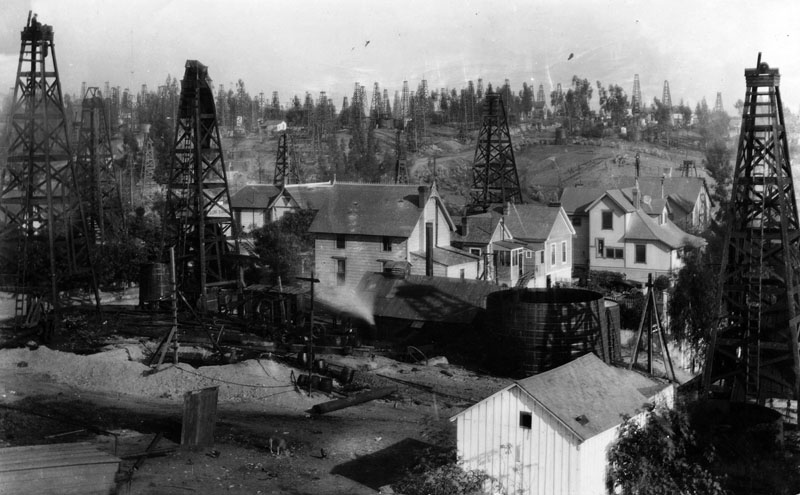 |
|
| View showing an oil field located just east of 1st Street and Belmont Avenue near downtown Los Angeles. |
Historical Notes The Los Angeles Oil Field (seen above) was once the top producing field in California, accounting for more than half of the state's oil. In its peak year, approximately 200 separate oil companies were active on the field, which is now entirely built over by dense residential and commercial development. |
What year was this famous oil field discovered?
A) 1850 B) 1870 C) 1890 D) 1910 |
Which of the following public facilities was built directly on the area of the former oilfield operations:
A) Shriners Hospital for Children B) St. Vincent Medical Center C) Belmont High School D) Edward R. Royball Learning Center |
Click HERE for Answers |
* * * * * |
Mystery History Questions (July 2018)
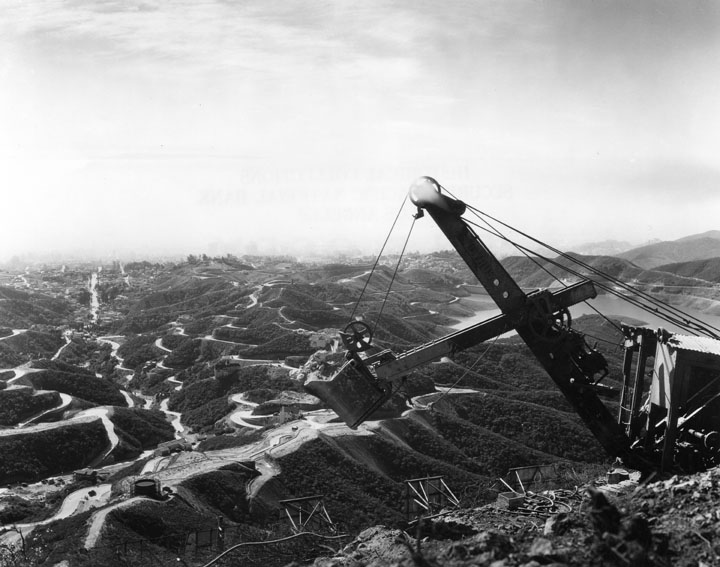 |
|
| View showing a steam shovel on a hillside overlooking rolling hills and newly carved winding roads. Also in the background (on the right) can be seen a dam and reservoir designed and built by William Mulholland. |
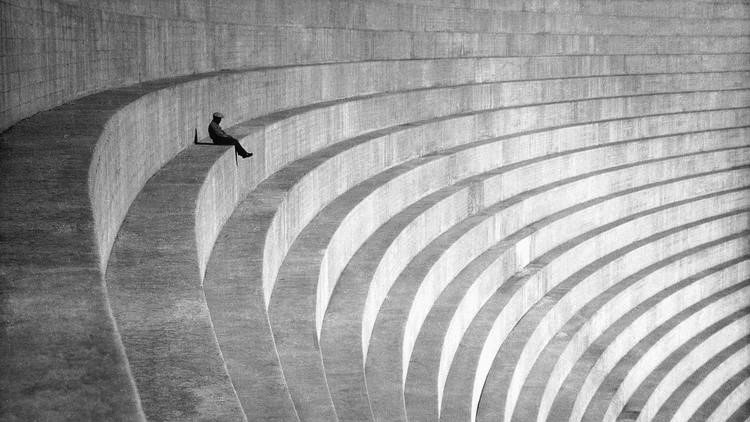 |
|
| Close-up view showing a man sitting on the vast, elegantly curved wall of the dam holding up the water reservoir seen in the previous image. Both the dam and reservoir were designated Los Angeles Historic-Cultural Monuments in 1989. |
What is the name of the reservoir?
A) St. Francis Reservoir B) Encino Reservoir C) Hollywood Reservoir D) Sawtelle Reservoir E) Silver Lake Reservoir |
When was it built?
A) 1907 - 1908 B) 1911 - 1912 C) 1917 - 1918 D) 1923 - 1924 E) 1932 - 1933 |
Click HERE for Answers |
* * * * * |
Mystery History Question (April 2018)
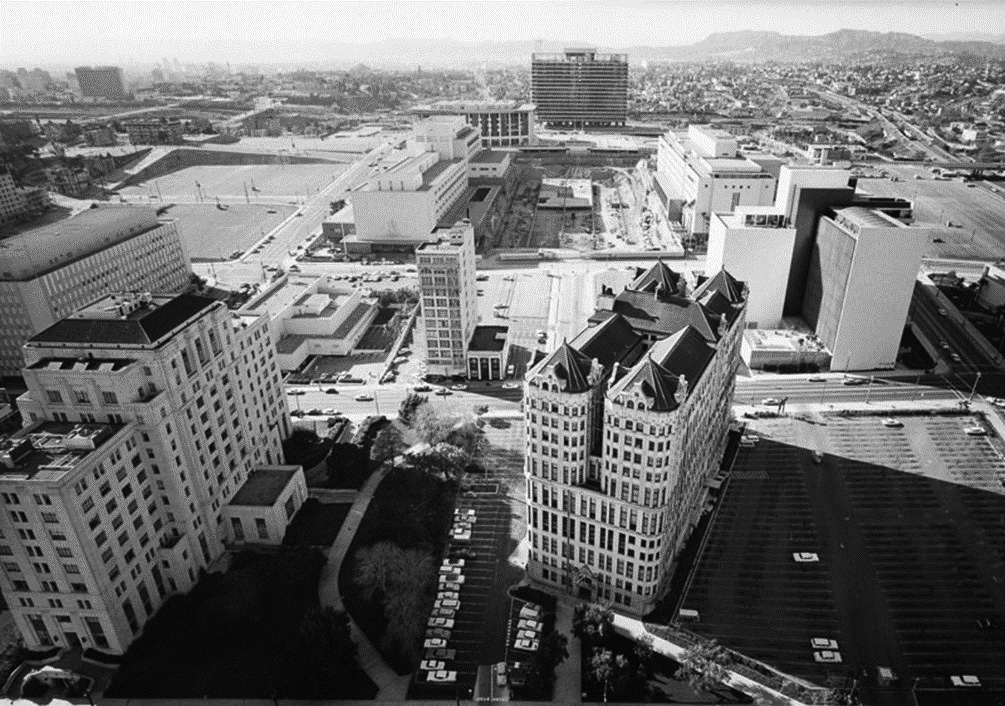 |
|
| (1960s) - This view is looking northwest toward the newly constructed Music Center and DWP Building (JFB) as seen from the observation deck of City Hall. |
Historical Notes In the foreground stand two well-known historic buildings, once located on the west side of Spring Street between 1st and Temple streets across from City Hall. The Gothic-style building at center-right was built in 1908 and demolished in 1973. The building at lower-left was built in 1931 and torn down in 1976. |
What were the names of these two buildings?
A) LA County Courthouse B) California State Building C) Hall of Justice D) Federal Courthouse and U.S. Post Office Building E) Hall of Records |
Click HERE for Answers |
* * * * * |
Mystery History Questions (January 2018)
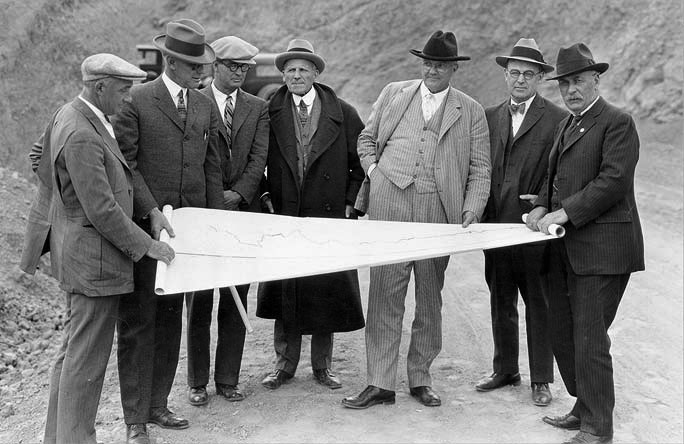 |
|
| A group of men survey a new construction project. The man on the right holding one end of the scrolled plans is William Mulholland. Harry Chandler is third man from the right. Next to him, at center, is the controversial Moses Sherman. |
What project are these men surveying?
A) Mulholland Dam B) St. Francis Dam C) Lower Van Norman Reservoir D) Sherman Way Extension E) Mulholland HIghway F) Silver Lake Reservoir |
What year was the project dedicated?
A) 1920 B) 1924 C) 1928 D) 1932 E) 1936 |
Click HERE for Answers |
* * * * * |
Mystery History Questions (October 2017)
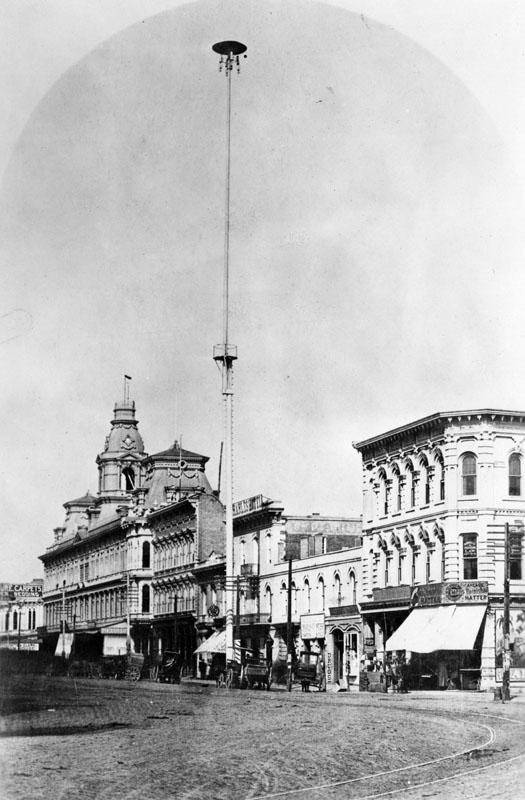 |
|
| View of the 300 block of N. Main Street showing one of Los Angeles’ 1st electric light poles. It was 150 feet tall and located in front of the St. Charles Hotel. |
Historical Notes C. L. Howland installed the City’s first seven 150-foot tall streetlight masts, each carrying three carbon-arc lamps of three thousand candle-power. He also installed a small power plant to provide the electricity for his new street light system. |
What year did Howland install LA’s first electric streetlights?
A) 1882 B) 1886 C) 1890 D) 1894 |
Howland and other investors would go on to form Los Angeles’ first electric utility. Name the utility:
A) L.A. Edison Electric Co. B) L.A. Electric Co. C) L.A. Gas and Electric Co. D) Pacific Light and Power Co. |
Click HERE for Answers |
* * * * * |
Mystery History Question (July 2017)
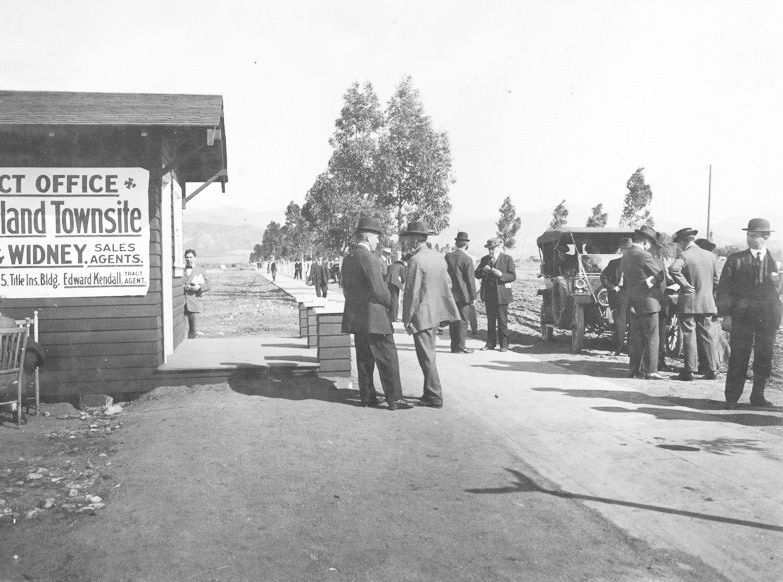 |
|
| A group of men stand in front of the Lenz & Widney Tract Office at the Mulholland Townsite. |
Historical Notes Walter M. Lenz and Robert J. Widney were sales agents for the project to develop the town of Mulholland and Mulholland Hills in the San Fernando Valley. The project was developed by the Mulholland Development Company. |
What year was Mulholland Town established?
A) 1907 B) 1912 C) 1917 D) 1922 E) 1927 |
What is the area (Township of Mulholland) called today?
A) Pacoima B) San Fernando C) Sunland D) Sylmar E) Tujunga |
Click HERE for Answers |
* * * * * |
Mystery History Question (April 2017)
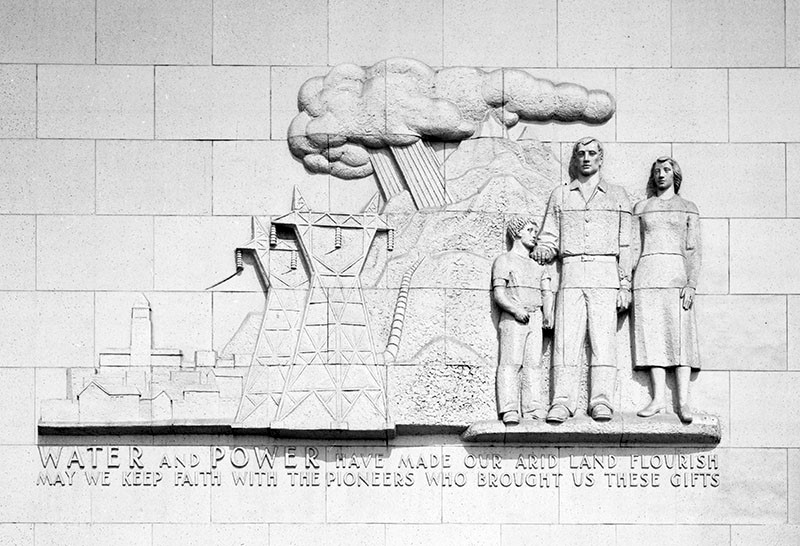 |
|
| View showing a life size bas-relief panel that honors the men and women who helped bring water and power to the southland. It is part of a larger monument honoring the pioneers that made it possible for the City of Los Angeles to flourish and become what it is today. The inscription reads: "Water and Power have made our arid land flourish. May we keep faith with the pioneers who brought us these gifts." |
What year was the monument dedicated?
A) 1928 B) 1938 C) 1948 D) 1958 E) 1968 |
Where is the monument located?
---------------------------------------- |
Click HERE for Answers |
* * * * * |
Mystery History Question (January 2017)
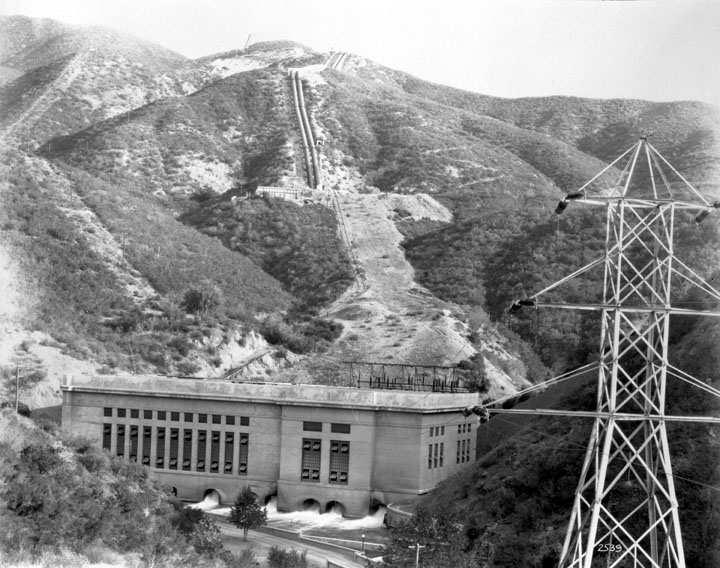 |
|
| View showing Power Plant No. 1 located in San Francisquito Canyon with transmission tower in lower-right and water penstocks seen in the distance. |
Background The completion of Power Plant No. 1 was the Los Angeles Bureau of Power and Light's (later DWP) first step in becoming an independent electricity provider. |
What year was the power plant completed?
A) 1913 B) 1917 C) 1921 D) 1925 E) 1929 |
Click HERE for Answer |
* * * * * |
Mystery History Question (October 2016)
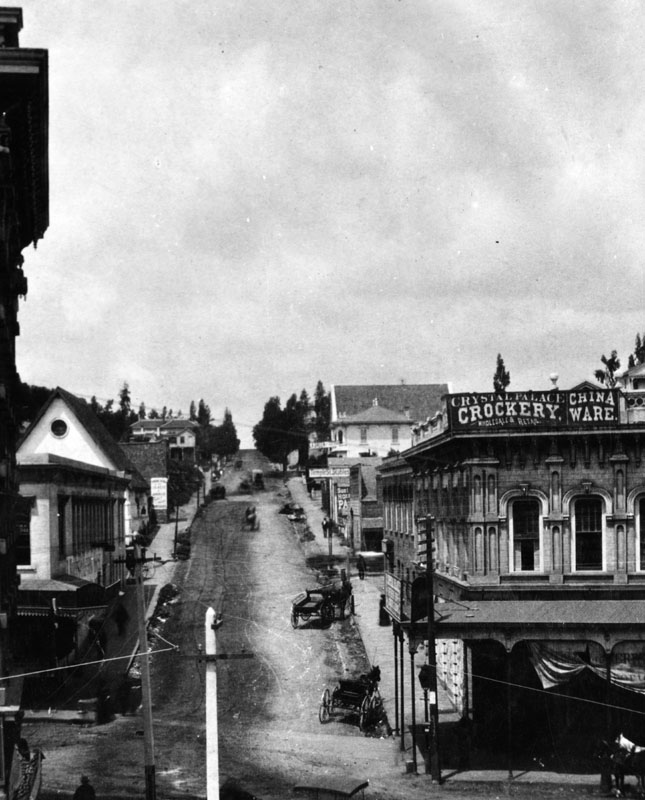 |
|
| Photo of early Los Angeles Civic Center. This view is looking west toward Bunker Hill showing an unpaved road with horse-drawn wagons parked along the curb. |
What is the name of this well-known Los Angeles Civic Center intersection?
_______________________________ |
What year was this photo taken?
A) 1874 B) 1884 C) 1894 D) 1904 |
Click HERE for Answers |
* * * * * |
Mystery History Question (July 2016)
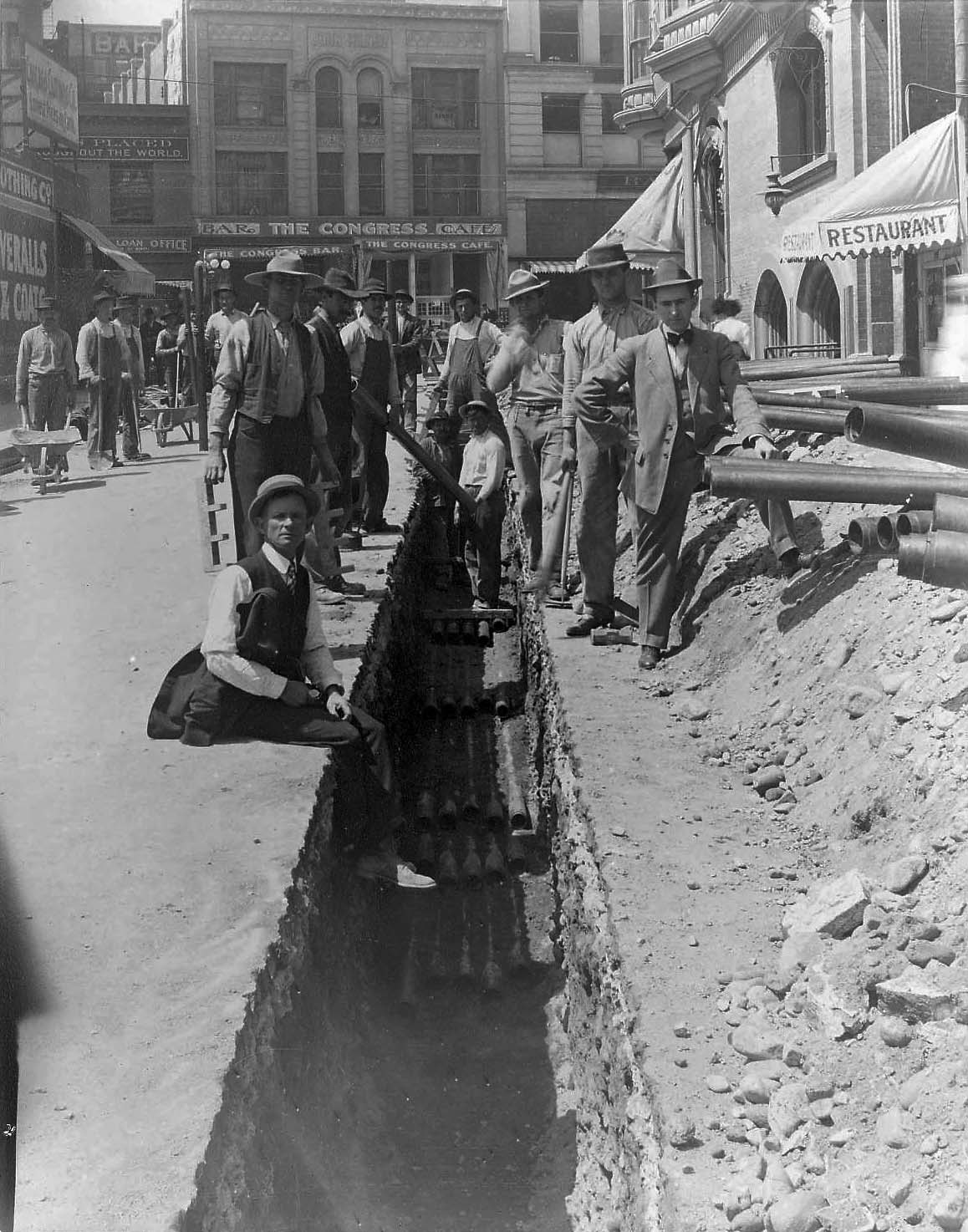 |
|
| View is looking northwest on Winston Street toward where it intersects with Main Street in downtown Los Angeles. A construction crew is installing conduit for electrical power cables. This is one of the oldest known electrical underground distribution systems installed in the City. Click HERE to see contemporary view. |
When was this photo taken?
A) 1890s B) 1900s C) 1910s D) 1920s |
Name the utility doing the work:
A) LA Gas and Electric Corp. B) LA Bureau of Power and Light C) LA Edison Electric Co. D) Pacific Light and Power |
Click HERE for Answers |
* * * * * |
Mystery History Question (April 2016)
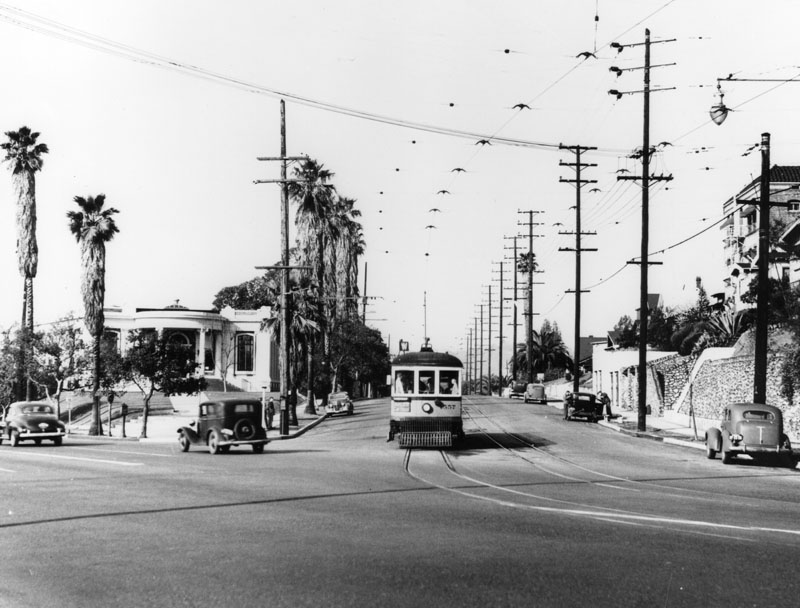 |
|
| This 1946 photo shows a streetcar heading east on Piedmont Avenue as it makes a turn onto N. Figueroa Street. Power poles line both sides of the street. LA’s first Municipal installed power pole stands on the corner at center-left. |
Background March 30th marks the anniversary of the beginning of the electrical distribution system of the Bureau of Power and Light (later LADWP) when the City installed its first power pole on the corner of Pasadena Avenue (now N. Figueroa St.) and Piedmont Street. The pole still exists today as can be seen in the following photo. |
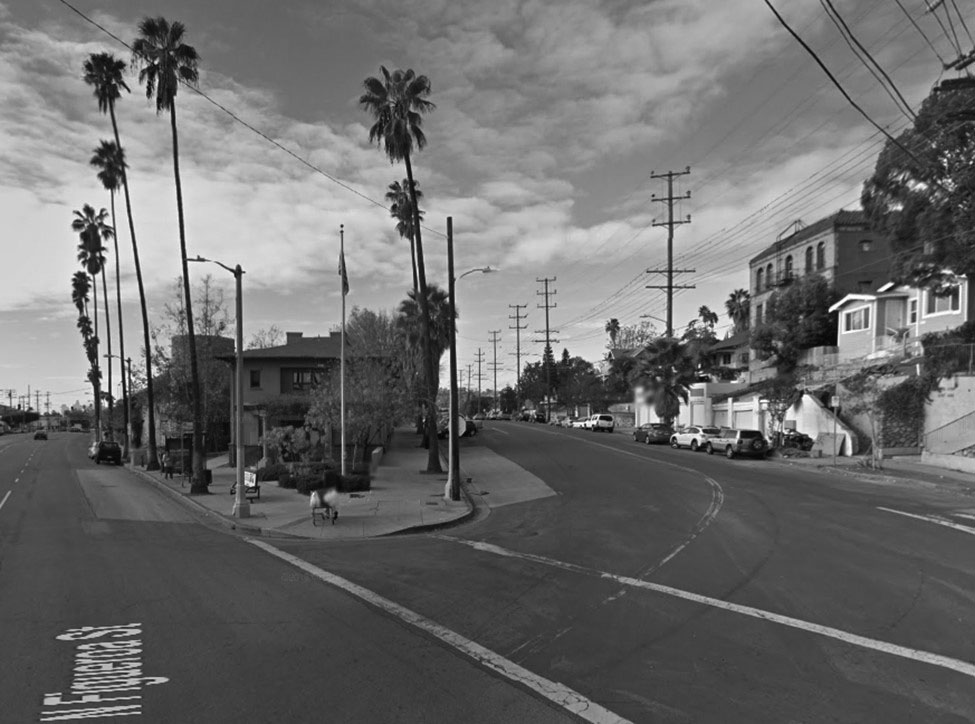 |
|
| (2016)*^ - View looking at the southwest corner of Piedmont Street and N. Figueroa Avenue in Highland Park, showing LA’s First Municipal installed power pole as it appears today. |
What year was LA's First Municipal Power Pole installed?
A) 1900 B) 1908 C) 1916 D) 1924 |
Click HERE for Answer |
* * * * * |
Mystery History Questions (Jan 2016)
.jpg) |
|
| This large four-story Victorian-style school stood on a hill overlooking downtown Los Angeles from 1882 until 1922. The exact location was at the intersection of Grand Avenue and 5th Street, where the Los Angeles Central Library stands today. |
What was the name of the school?
A) Los Angeles Academy
B) Los Angeles Trade Tech
C) State Normal School
D) St. Vincent's College
Over the years the above school evolved into one of the most recognized learning institutions in the nation:
A) Cal Lutheran
B) USC
C) UCLA
D) Loyola of Marymount
Click HERE for Answers |
* * * * * |
Mystery History
The following photos show two early water reservoirs used by the City of Los Angeles in the late 1800s: |
|
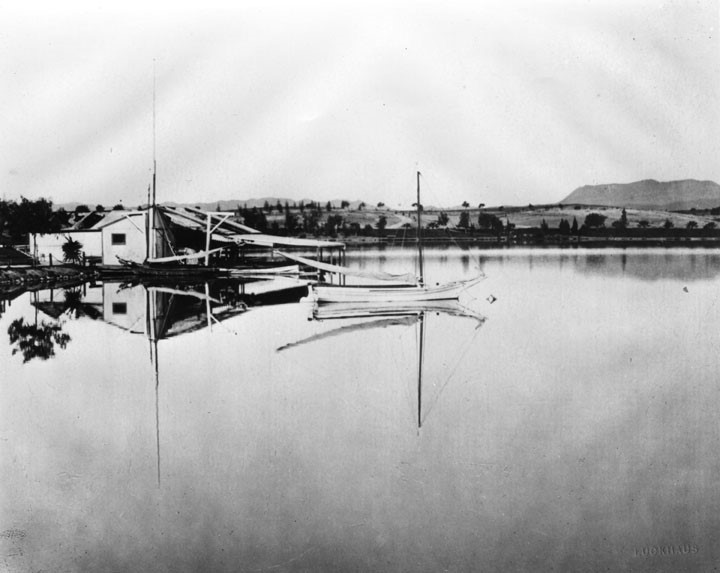 |
|
| (1880s) - View looking northwest showing a large body of water with boat house and sailboat. The Hollywood Hills can be seen in the distance. This man-made lake was used as a water reservoir until the turn of the century when it was converted into a public park. |
.jpg) |
|
| (1895) - View looking northeast showing a large body of water with the snow-capped San Gabriel Mountains in the distance. Originally used as a reservoir for the City of Los Angeles, it was later converted into a park. |
No longer used as reservoirs, the above two bodies of water are now well known city parks. What are their names?
Park No. 1: _____________________
Park No. 2: _____________________
Click HERE for Answers |
* * * * * |
Mystery History
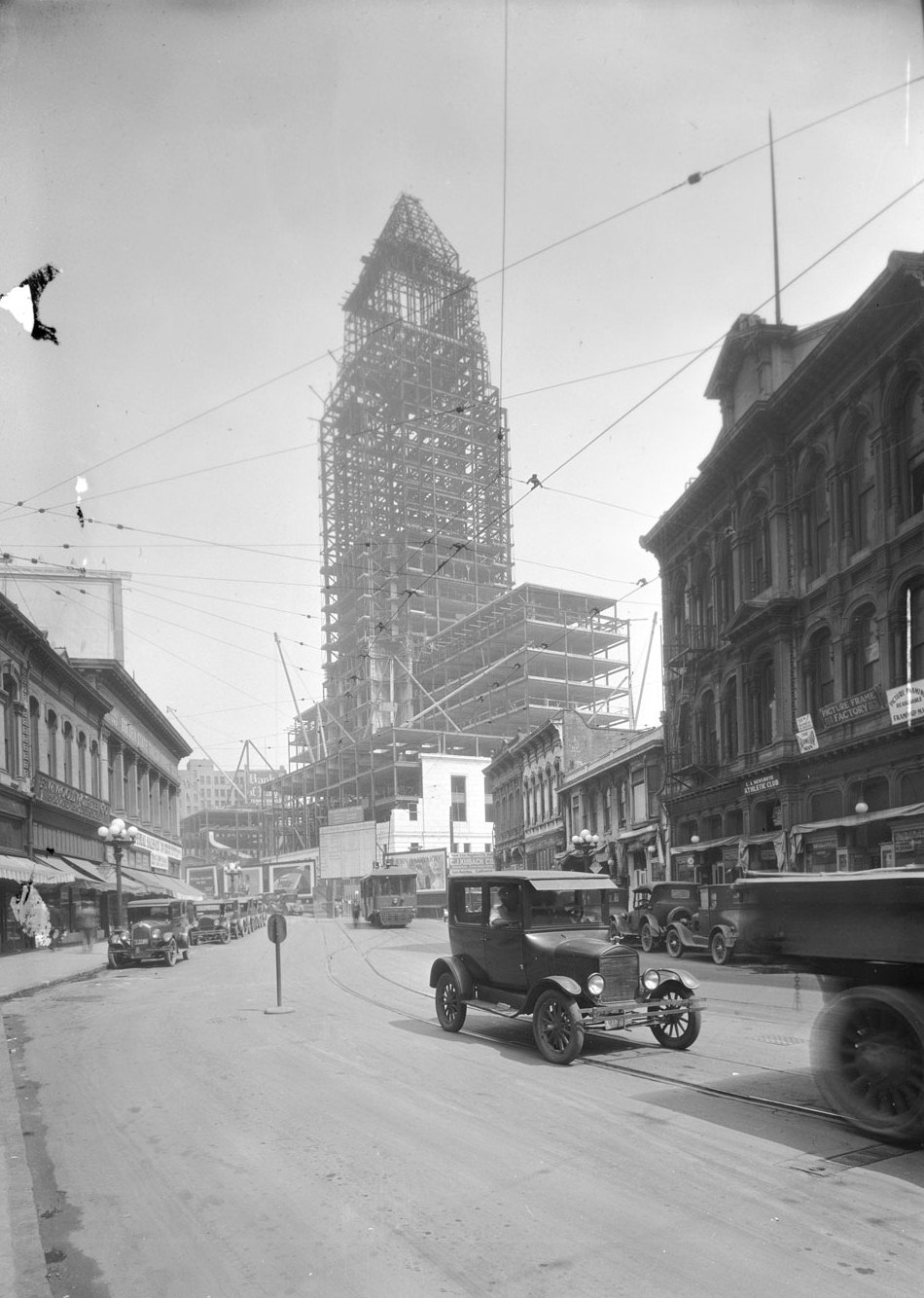 |
|
| View showing the steel framing of Los Angeles City Hall during its construction. |
Background A new City Hall was needed to replace the old 1888-built City Hall building located on Broadway between 2nd and 3rd Streets. After authorizing a bond issue, the city commissioned John Parkinson, Albert C. Martin*, and John C. Austin as architects for the new Los Angeles City Hall. Parkinson was responsible for the concept and architectural design of the building; Martin, the structural design; and Austin, the working drawings and general administration of the project. * Also known for design of the John Ferraro Office Building among others. |
Question #1
What year was City Hall built?
a) 1920 |
b) 1924 |
c) 1928 |
d) 1932 |
Question #2
Since it was incorporated in 1850, how many City Hall buildings has Los Angeles had?
a) Two |
b) Three |
c) Four |
d) Five |
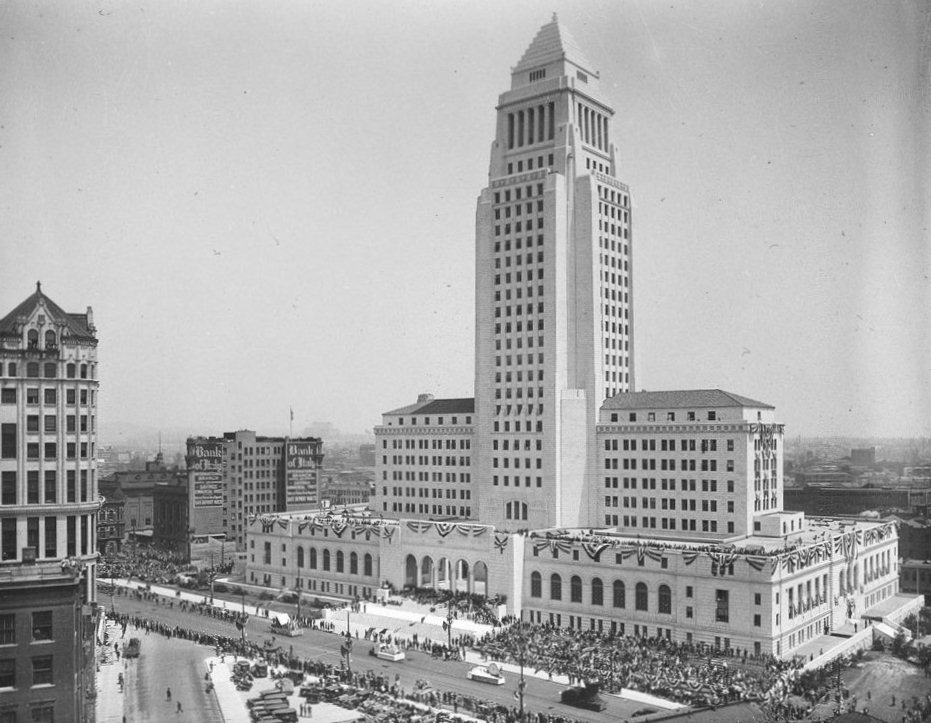 |
|
| View of Los Angeles City Hall decorated with banners for its opening ceremony. A crowd of people are gathered at the curb, bleachers are full of spectators, and a parade is in progress on Spring Street. |
Background For years, the Charter of the City of Los Angeles did not permit any portion of any building other than a purely decorative tower to be more than 150 feet. At 28 stories and 454 feet high, City Hall was the only exception making it the tallest building in Los Angeles for years to come. |
Question #3
Until what year did City Hall continue to be the tallest building in Los Angeles?
a) 1934 |
b) 1944 |
c) 1954 |
d) 1964 |
Click HERE for Answers |
* * * * * |
Mystery History
 |
|
| Operator J. A. Griffitts is seen here opening the circuit breaker on the last DWP 50 cycle circuit. Taken in the old control house at RS-C in Wilmington. |
Background In the early days, the Southland was sort of an electrical enclave. Both Edison and DWP generated and distributed their power at 50hz where most parts of the country were at 60hz. Some electrical appliances worked at both frequencies, but for frequency-sensitive products manufacturers created special 50hz models just for the Southern California market. And when newcomers moved from outside the region, they paid to have their old devices converted, or simply bought new ones that would work on the 50hz grid. |
Question #1
What year did DWP convert its frequency from 50hz to 60hz?
|
Question #2
What event prompted DWP to convert its operating frequency to 60hz?
---------------------------------------- |
Question #3
What year did SCE convert its frequency to 60hz?
|
Click HERE for Answers |
* * * * * |
Mystery History
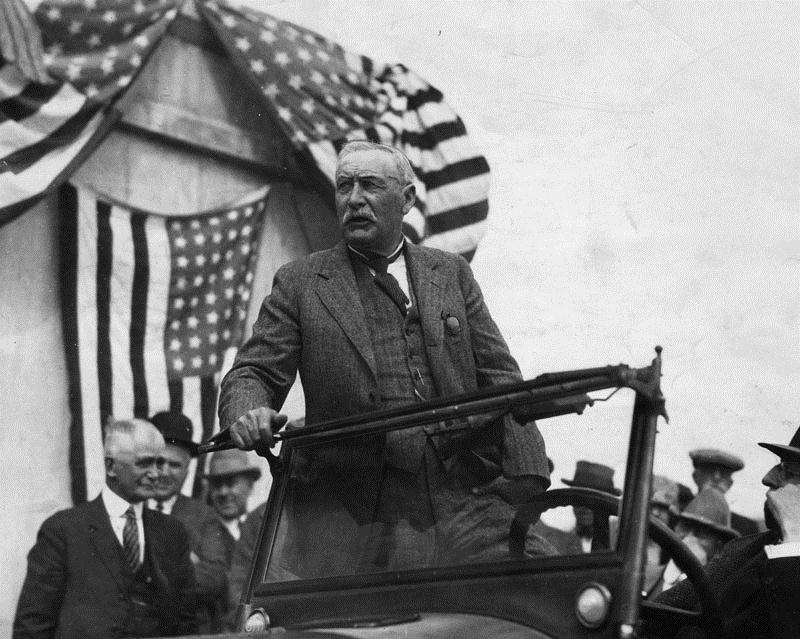 |
|
| This often seen photo of William Mulholland standing in an early model car, with American Flags and Banners in the background, was taken at the opening ceremony of a new facility. |
- What is the name and location of this facility? __________
(Hint: The year was 1925).
Click HERE for Answers |
* * * * * |
Mystery History
 |
|
| Aerial photograph taken in 1945 from above Bunker Hill, where the DWP’s office building (JFOB) stands today, looking east toward the Los Angeles Civic Center. The ornate building in front of City Hall is the Old Hall of Records. The Hollywood and Harbor Freeways would not be constructed until the early 1950s. |
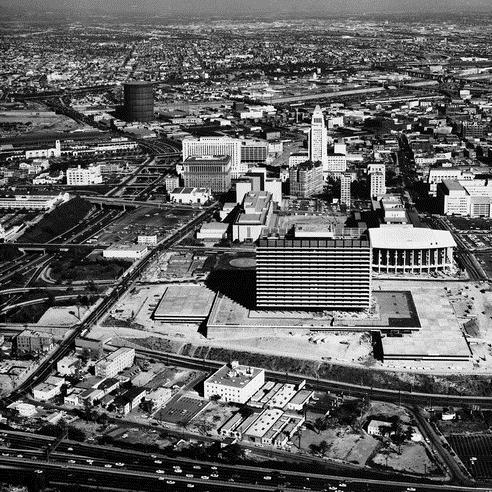 |
|
| Aerial view looking east toward the Civic Center showing a not quite completed DWP General Office Building (later JFOB), located on Bunker Hill. |
Question #1
- What year was the DWP General Office Building (GOB) constructed? _______
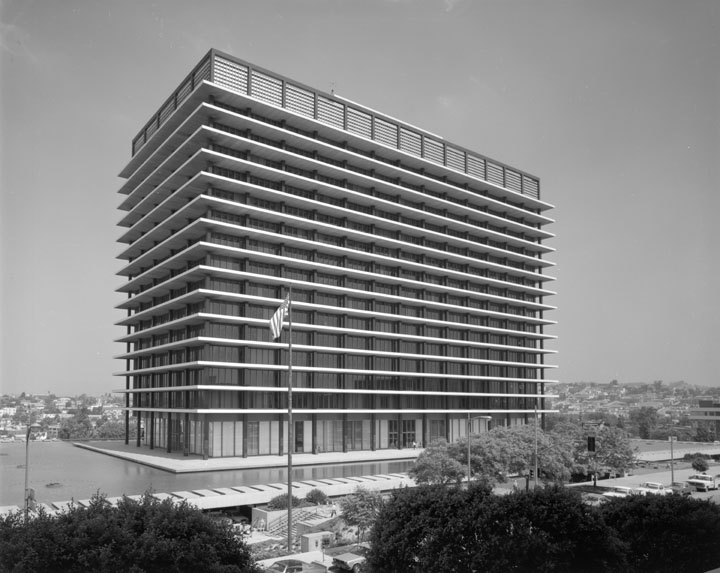 |
|
| The Los Angeles Department of Water and Power Office Building (Referred to as the GOB or JFOB).* |
Question #2
- What year was the General Office Building (GOB) renamed the John Ferraro Office Building (JFOB)? _______
Question #3
- What year was the JFOB designated a Los Angeles Historic-Cultural Monument? _______
Click HERE for answers and more information on the JFOB |
* * * * * |
Mystery History
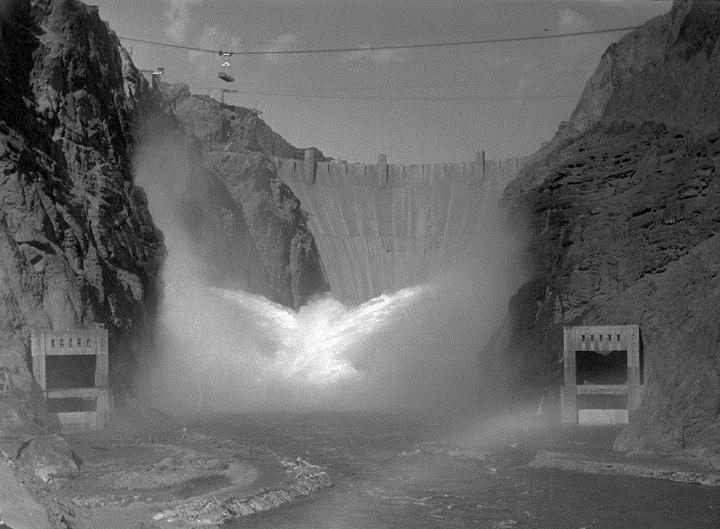 |
|
| (1936) - View showing the first time all 12 valves in the canyon wall outlets at Hoover Dam worked simultaneously, discharging Colorado River water. |
Background Ezra Scattergood pushed for a bill authorizing the construction of the Boulder Canyon Project (Hoover Dam). Despite attempts to discredit the project, Scattergood helped convince Congress in 1928 to pass the legislation and allow construction of the dam and a hydroelectric power plant. |
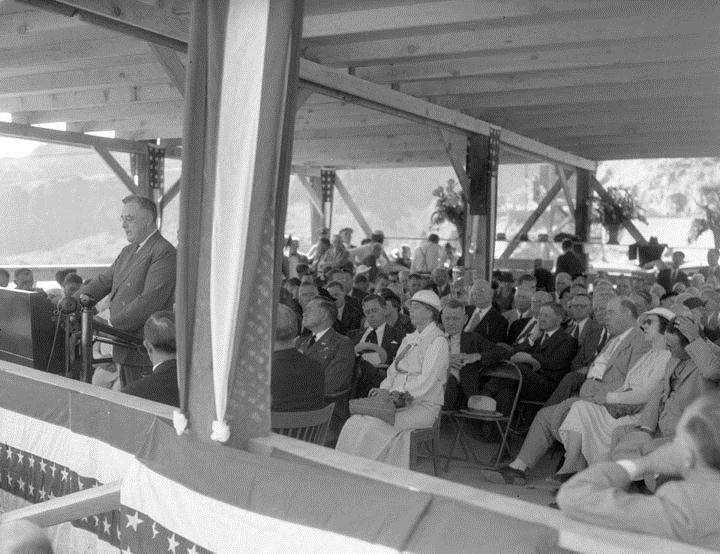 |
|
| (1935) – Dedication of Hoover Dam by President F. D. Roosevelt. |
Question #1
The above photo shows President F. D. Roosevelt giving a speech at the Dedication of Hoover Dam on September 30, 1935. Can you locate Ezra Scattergood on stage in the background?
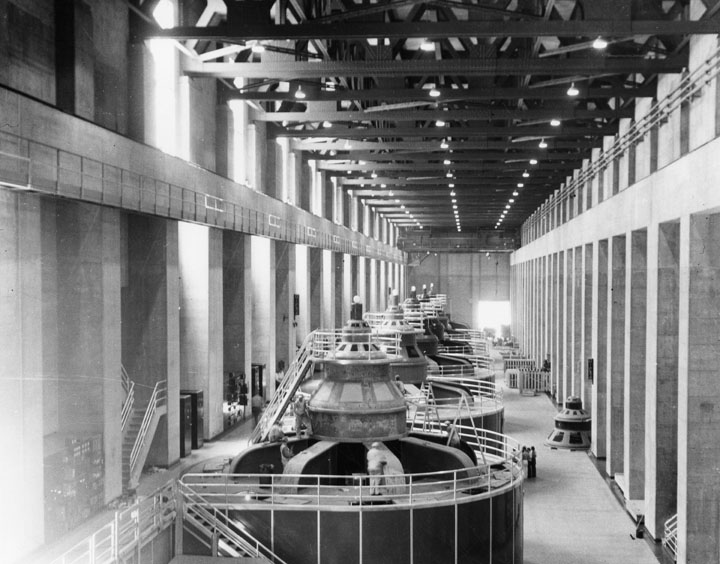 |
|
| (ca. 1936)* - View of the upper generator room at Hoover Dam, on the Nevada side, where there are eight generators. (The Arizona side has nine.) |
Question #2
What percentage of the L.A.’s power needs did Hoover Dam provide back in 1936?
|
Question #3
What percentage of L.A.’s power needs does Hoover Dam provide today?
|
Click HERE for answers and more information on Hoover Dam |
* * * * * |
Mystery History
Since the beginning of recorded history, earth-filled reservoirs have been used to help cities get through periods of drought. Los Angeles has been utilizing these types of reservoirs since the late 1800s. The following two photos show one of LA’s earliest water reservoirs, put into service in 1908.
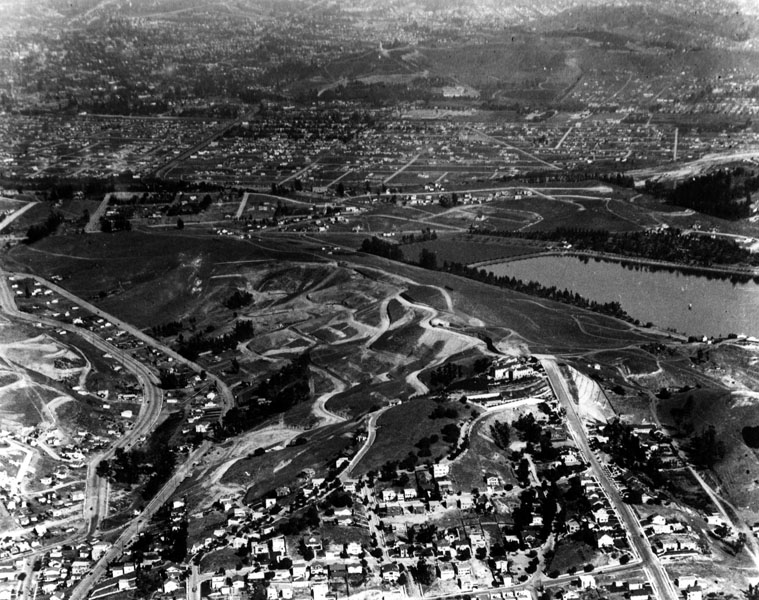 |
|
| (ca. 1924) - View looking north of the _____________Reservoir and surrounding area, with streets readied for new housing development. |
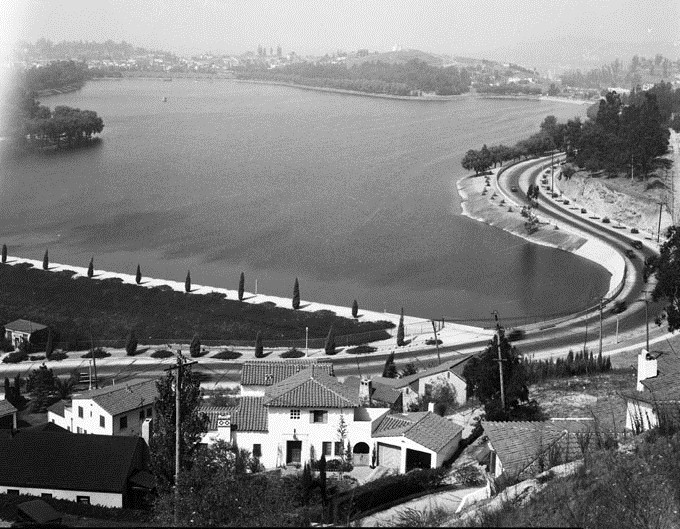 |
|
| (1930) - View of the ______________Reservoir named for _______________. The reservoir is an earth fill dam, asphalt concrete, with paved slopes. In 1989, it was designated LA Historic-Cultural Monument No. 422. |
1) What is the name of this reservoir located just north of downtown Los Angeles?
(Clue: The community it sits in was named after this reservoir.)
2) Who was the reservoir named after?
(Clue: It’s not gold.)
Click HERE for answer and more information on Early L.A. Water Reservoirs |
* * * * * |
Where's Waldo?
Can you locate William Mulholland in the following 1912 photo? Clue: He's wearing a hat....
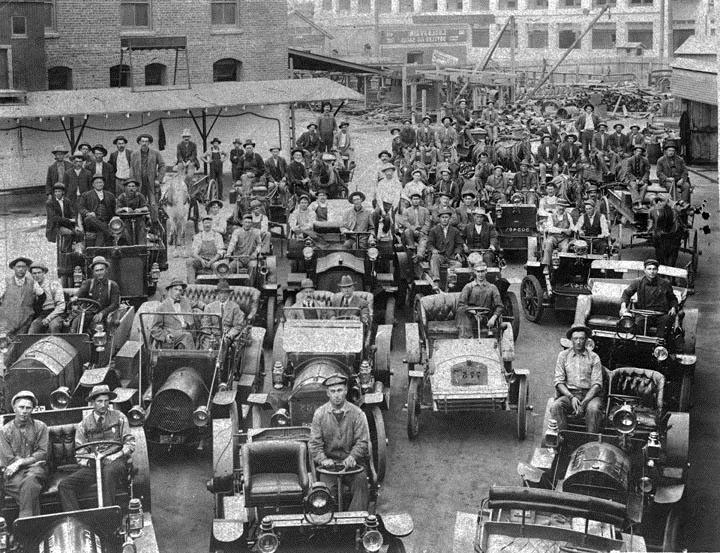 |
Click HERE for answer and more information on photo. |
* * * * * |
Mystery History
The photo below shows construction crews in cars and horse-drawn wagons in front of the City's first Water Department building. The building stood until 1939.
a) Where was the Water Department building located? __________b) What year was the Water Department (later DWP) formed? __________ |
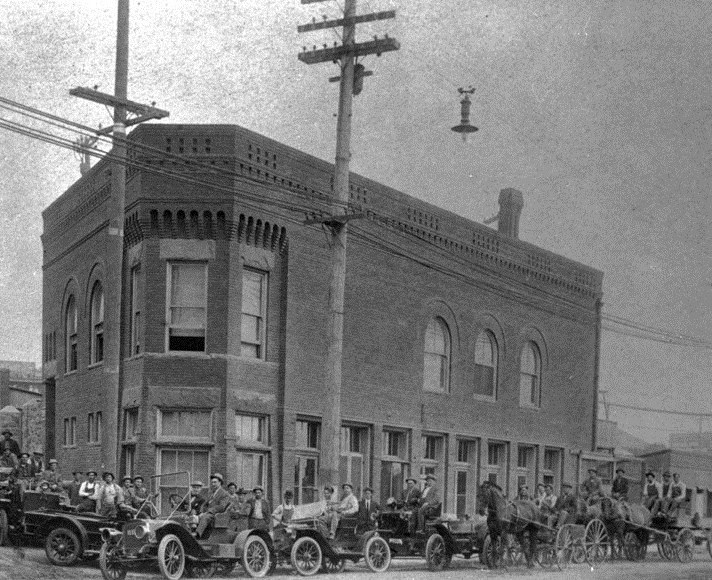 |
Click HERE to see more in Water Department's Original Office Building |
* * * * * |
Mystery History
Below is a photo showing a parking lot full of older model cars and horse-drawn carriages. This event occurred in the early 1900s and was one of the most significant milestones in the history of Los Angeles.
a) Name the event: __________b) What was the date of the event? __________ |
.jpg) |
Click HERE to see more in Opening of the Los Angeles Aqueduct |
* * * * * |
Mystery History
The photo below is not that of a time machine. It is the stator of a generator used in one of the first hydro power plants constructed by the Los Angeles Bureau of Power and Light (DWP).
a) What is the name of the power plant? __________b) Where is it located? __________ |
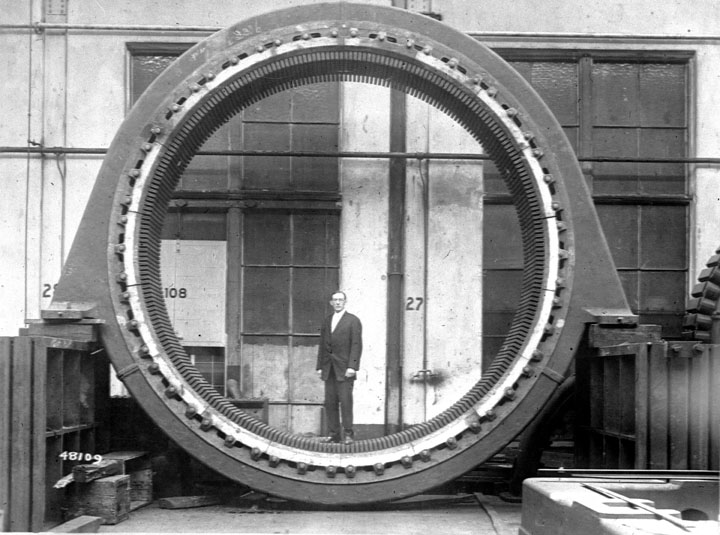 |
Click HERE to see more in Electricity on the Aqueduct |
* * * * * |
< Back
Menu
- Home
- Mission
- Museum
- Major Efforts
- Recent Newsletters
- Historical Op Ed Pieces
- Board Officers and Directors
- Mulholland/McCarthy Service Awards
- Positions on Owens Valley and the City of Los Angeles Issues
- Legislative Positions on
Water Issues
- Legislative Positions on
Energy Issues
- Membership
- Contact Us
- Search Index